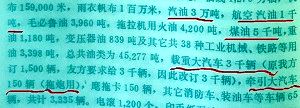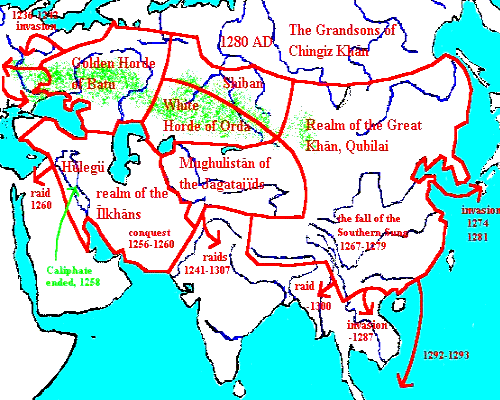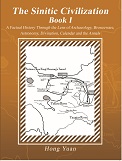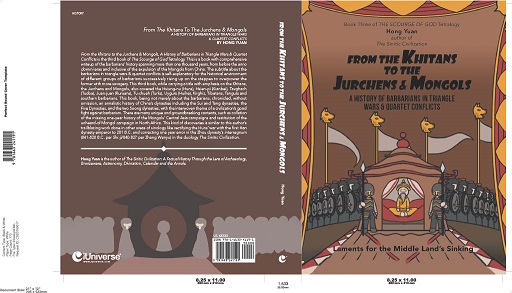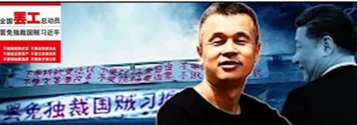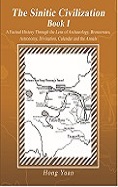
Sinitic Civilization-Book 1
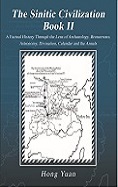
Sinitic Civilization-Book 2
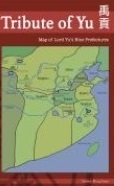
Tribute of Yu

Heavenly Questions
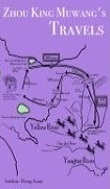
Zhou King Muwang's Travels
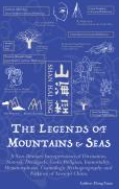
The Legends of Mountains & Seas
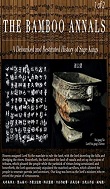
The Bamboo Annals - Book 1
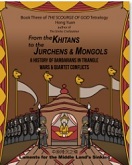
The Scourge-of-God-Tetralogy:
From the Khitans to the Jurchens & Mongols: A History of Barbarians in Triangle Wars and Quartet Conflicts
(available at iUniverse;
Google;
Amazon;
B&N)
|
|
THE YUAN DYNASTY
 The Scourges-of-God Tetralogy
would be divided into four volumes covering
Hsiung-nu (Huns), Hsien-pi (Xianbei), Tavghach
(Tuoba), Juan-juan (Ruruans), Avars, Tu-chueh (Turks), Uygurs (Huihe), Khitans, Kirghiz, Tibetans, Tanguts, Jurchens, Mongols and Manchus and
southern barbarians.
Book I of the tetralogy would extract the contents on the Huns from
The Sinitic Civilization-Book II,
which rectified the Han dynasty founder-emperor's war with the Huns on mount Baideng-shan to A.D. 201 in observance of the Qin-Han dynasties' Zhuanxu-li calendar.
Book II of the Tetralogy would cover the Turks and Uygurs.
And
Book IV would be about the Manchu conquest of China.
The Scourges-of-God Tetralogy
would be divided into four volumes covering
Hsiung-nu (Huns), Hsien-pi (Xianbei), Tavghach
(Tuoba), Juan-juan (Ruruans), Avars, Tu-chueh (Turks), Uygurs (Huihe), Khitans, Kirghiz, Tibetans, Tanguts, Jurchens, Mongols and Manchus and
southern barbarians.
Book I of the tetralogy would extract the contents on the Huns from
The Sinitic Civilization-Book II,
which rectified the Han dynasty founder-emperor's war with the Huns on mount Baideng-shan to A.D. 201 in observance of the Qin-Han dynasties' Zhuanxu-li calendar.
Book II of the Tetralogy would cover the Turks and Uygurs.
And
Book IV would be about the Manchu conquest of China.
From the Khitans to the Jurchens & Mongols: A History of Barbarians in Triangle Wars and Quartet Conflicts
, i.e., Book III of
the Scourge-of-God-Tetralogy,
focused on the Khitans, Jurchens and Mongols, as well as provided the annalistic history on the Sui and Tang dynasties, the
Five Dynasties & Ten Kingdoms, and the two Soong dynasties.
Similar to this webmaster' trailblazing work in rectifying the Han dynasty founder-emperor's war with the Huns to 201 B.C. in The Sinitic Civilization - Book II,
this Book III of the Scourge-of-God-Tetralogy
collated
the missing one-year history of the Mongols' Central Asia campaigns and restituted the
unheard-of Mongol campaign in North Africa.
|
The Scourges of God: A Debunked History of the Barbarians" - available at iUniverse|Google|Amazon|B&N
From the Khitans to the Jurchens & Mongols: A History of Barbarians in Triangle Wars and Quartet Conflicts
(The Barbarians' Tetralogy - Book III)
Epigraph,
Preface,
Introduction,
Table of Contents,
Afterword,
Bibliography,
References,
Index
|
|
Table of Contents
(From the Khitans to the Jurchens & Mongols: A History of Barbarians in Triangle Wars and Quartet Conflicts)
Chapter XX: The Mongols ...................................................................................363
Origin of the Mongols: Mengwu Shiwei .................................................................365
The Mongol Legends ............................................................................................370
Genghis Khan's Mongols Called Themselves by the Da-da ('Ta-ta-er') .................375
Meng2gu3 State and/or Mongols' Conflicts & Feuds with the Jurchens ..................378
The Mongols' Kinsmanship with the Khitans and Jurchens ......................................381
Chapter XXI: The Turco-Mongol Tribes & Clans ...................................................383
The Tayichi'ut ........................................................................................................383
The Jurkin .............................................................................................................385
The Oirats ............................................................................................................386
The Onggirat & Genghis Khan's Wife ....................................................................387
The Jadirats and Genghis Khan's blood-brother Jamuka ........................................387
The Tatars (Ta-ta-er, not today's misnomer Tartars) ...............................................391
The Naimans (Turco-Mongol) ...............................................................................392
The Keraits (Turkic) ............................................................................................. 394
The Merkits & the Women Abduction ....................................................................396
The Jalair................................................................................................................398
The Wang'gu (Vuanggu, Wanggu, Ongud, Ongut) ...................................................399
The Kirghiz ............................................................................................................399
Genghis Khan's Family Members of Six Brothers & Four Sons, Four Steeds &
Four Dogs .................................401
Chapter XXII: The Mongol Attacks on the Tatars, Naimans, Keraits, Tanguts,
Jurchens, Khitans in Manchuria & Kara-Khitay (from A.D. 1202
to 1219) .......................403
Attack on the Tanguts .............................................................................................405
The Mongol Attack on the Jurchens ........................................................................407
The Battles of Huan'erzui (badger mouth) & Yehuling (wild fox ridge) ......................409
The Battle of Migukou (secret valley entrance) .........................................................413
The Mongol's Second Campaign against the Jurchens (A.D. 1213) ..........................414
Attack on the Kara-Khitay (A.D. 1214) ...................................................................415
The Mongols' Sacking the Jurchen Capital City of Zhongdu ......................................416
Attack on the Khitans in Manchuria ...........................................................................417
The Quartet Wars among the Mongols, Jurchens, Tanguts and Southern Soong ...........418
The Mongol Attacks on the Keraits & Kara-Khitay ...................................................420
Southern Soong's Recovering the Shan-dong & He-bei Territories .............................421
Continuous Mongol Attacks on the Tanguts ............................................................. 421
The Mongol Attack on the Khitans along the Manchuria-Koryo Border ....................422
Chapter XXIII: The Mongol Campaigns Against Semiryechye & Central Asia
(A.D. 1216-1224) .................423
The Mongol Campaign against Kuchlug's Kara-Khitay (A.D. 1218) .......................425
The Fergana Valley Campaign, and the Battles of Oyrat, Bukhara, Samarkand
(A.D. 1219-1220) ................426
Subetei & Chepe Chasing the Khwarazm Shah to Balkh, Neyshabur, Urgenchi,
A-la-hei (Alajeh, Amol) , Demavend Mountain, Qazvin, and the Caspian Sea
(A.D. 1220) ........................431
Jala ad-Din's Succession as the Khwarazm Sultan (Shah) ........................................433
The Amu Darya River Sweep Campaign (A.D. 1220-spring 1221) ......................... 433
Siege of the Urgenchi Twin Cities (autumn of A.D. 1221-spring of A.D. 1222) ..........435
Battle of the Buzgala Pass (April of A.D. 1221) .......................................................437
Tolui's Khorasan, Mazandaran and Arsacia Campaigns (autumn of A.D.
1221-spring of 1222) ..................................................439
Battle of the Taloqan Castle (autumn 1221-March of A.D. 1222) .............................440
The Battles of Bamiyan and Beruwan (summer of 1222) .......................................... 441
The India Campaign (A.D. 1222-1224) ....................................................................444
Subetei and Chepe's Campaign in the Caucasus (A.D. 1220-1222) ..........................447
The First European Campaign (A.D. 1222-1223) .....................................................448
The Mongols' Continuous Campaigns against Iraq-i Ajam and Transcaucasia
(A.D. 1230-1240) .....................................450
Chapter XXIV: Demise of the Tangut Xia Dynasty (A.D. 1038-1227) .........................453
Chapter XXV: Demise of the Jurchen Jin Dynasty (A.D. 1115-1234) ...........................458
Chapter XXVI: OGEDEI KHAN (r. A.D. 1229-1241) ...............................................477
Chapter XXVII: The Second European Campaign (A.D. 1236-1242) ..........................483
The Mongol Attack on the Bulgars, Kipchaks and Alans (A.D. 1236-1237,
1238-1239, 1242) ....................483
The Mongol Attack on the Northern Rus Principalities (A.D. 1237-1238, 1239) ............484
The Mongol Attack on the Kipchaks, Alans, Crimea & Caucasus (A.D. 1238-1240) .... 487
The Mongol Attack on the Kiev Rus Principality (A.D. 1240) ........................................489
The Mongol Attack on Poland, Bohemia, Moravia, Hungary, Austria & Dalmatia
(A.D. 1240-1242) ...........................491
Chapter XXVIII: DOWAGER-EMPRESS TOREGENE (r. A.D. 1241-1246),
GUYUK KHAN (r. A.D. 1246-1248), & OGHULGAMISH'S
REGENCY (r. A.D. 1249-1251) ................ 506
Chapter XXIX: Mengke Khan (r. A.D. 1251-1259) ......................................................509
Chapter XXX: The Mongol Conquest of the Mywa (Dali) State ....................................513
Chapter XXXI: The Mongols' Third Western Campaign in the Middle East &
North Africa (A.D. 1252-1260) ........................519
Chapter XXXII: Mengke Khan's Death in the Siege of the Hook-Line Fishing Castle .....524
Chapter XXXIV: Southern Soong vs. the Mongols ........................................................571
The Duanping Northern Expedition against the Mongols (A.D. 1234) .............................571
Ogedei Khan's Campaign against Southern Soong .........................................................572
Cao Youwen Defeating the Mongols at Qingyeyuan and Defending the
Yangpingguan-Jiguan'ai Passes (A.D. 1236)...................... 577
The Mongols Ravaging the Sichuan Basin from A.D. 1236 to 1279 .................................582
The Mongols' War against Southern Soong during Toregene, Guyuk &
Oghul-qaimish's Reigns ..........................585
The Mongols' Recurring Attacks against the Sichuan Mountain Forts &
the Han-shui River Bend Forts through the A.D. 1250s ...................589
The Third Mongol Campaign against Hezhou (Caaju) & Diaoyucheng
(A.D. 1257-1259) ............................596
Chapter XXXV: Khubilai's War Against Southern Soong ..................................................603
Khubilai Khan's Sinicization & Southern Soong's Northern Expedition to Echo Li
Tan3's Rebellion .......................608
Khubilai Khan Launching the Yuan Dynasty (A.D. 1271) ....................................................612
The Mongols' Continuous Campaigns in the Sichuan Basin for Two Decades .......................613
Soong Emperor Duzong (Zhao Qi, r. A.D. 1264-July 1274) ................................................616
The Mongol Siege of Xiangyang & Fancheng Twin Cities (A.D. 1267-1273) .......................617
The Mongols' Campaign against the Triangular Vertices of Ying3zhou, Jiangling
and Yueyang (A.D. 1274-1275) ........................623
Soong Emperor Gongdi (Zhao Xian, r. A.D. 1275-1276) ....................................................626
Soong Dowager-Empress Surrendered the Capital City Lin'an to the Mongols
(February of A.D. 1276) ..................631
Continuous Resistance in the Sichuan Basin and Southwestern China ....................................635
Soong Emperor Duanzong (Zhao Shi, r. A.D. 1276-1278) & Emperor Shaodi
(Zhao Bing, r. A.D. 1278-1279) ...........640
Demise of the Southern Soong Dynasty (A.D. 1127-1279) ...................................................644
The Mongols' Weapon Prohibition Order against the Chinese ................................................648
Chapter XXXVI: The Death Toll from the Mongol Conquest .................................................650
Section Seven: The Yuan Dynasty (A.D. 1271-1368)
Chapter XXXVII: Khubilai Khan (r. A.D. 1260-1294) ......................................................... 657
Khubilai Defeating Contender-khan Arik-Buka at Karakorum ................................................659
Khubilai Launching the Sinicized Yuan Dynasty (A.D. 1271-1368) .........................................660
The Conquest of Southern Soong ..........................................................................................666
Chapter XXXVIII: The Mongol Invasion of Koryo, Japan, Vietnam, South &
Southeast Asia & Island States .................669
The Invasion of Koryo & Japan ............................................................................................669
The Invasion of Burma, Champa & Annam ............................................................................675
The Invasion of Java, Declaring Amnesty, and Khubilai's Death ..............................................686
Chapter XXXIX: The Mongol Internal Strife ..........................................................................687
Chapter XL: The Yuan Dynasty Emperors ..............................................................................692
Emperor Chengzong (Borjigin Temur, r. A.D. 1294-1307) ......................................................692
Emperor Wuzong (Borjigin Qayisang, r. A.D. 1307-1311) ......................................................693
Emperor Renzong (Borjigin Ayuur-balbad, r. A.D. 1311-1320) ...............................................693
Emperor Yingzong (Borjigin Sidibala, r. A.D. 1320-1323) .......................................................695
Emperor Taidingdi (Borjigin Yisun-temur, r. A.D. 1323-1328) .................................................696
Emperor Tianshundi (Borjigin Razibay, r. A.D. 1328) .............................................................. 696
Emperor Wenzong (Borjigin Tob-temur, r. A.D. 1328-1329, 1329-1332) ...............................697
Emperor Mingzong (Borjigin Kusele/Kusala, r. A.D. 1329) .....................................................697
Emperor Ningzong (Borjigin Rincinbal, r. A.D. 1332) ..............................................................698
Emperor Shundi (Borjigin Toyan-temur/Toghan-temur, r. A.D. 1333-1370) ..............................698
Chapter XLI: The Red Turbans' Rebellion Against the Mongols ...............................................701
Chapter XLII: The Ming Dynasty vs. the Mongols ..................................................................720
|
|
Khubilai Khan and the Yuan (First) Dynasty (A.D. 1271-1368)
In August 1259, Mengke Khan died on Mount Diaoyushan of the Hezhou Prefecture (today's Sichuan Province) after failing to take over a Soong castle. The Mongols hence called off the campaign.
Later in 1279, the Mongols avenged the shame of Mengke Khan's possible bombardment death by killing 1.4 million residents of the Chengdu city.
But, Diaoyu-cheng was spared. The fort would not surrender to the Mongols till A.D.1279 when Wang Li4, an officer under Zhang Jue and a commanding general of the former Meng Gong's Ningwu-jun Army, took the persuasion of Mongol official Li Dehui to surrender the fort.
Li Dehui previously taught Khubilai's second son Zhen-jin (true gold) with the recommendation from Liu Bingzhong, a person who managed to save China's souls on the same par as Yelü Chucai and Ogodei Khan's quasi-adopted son Yang Weizhong.
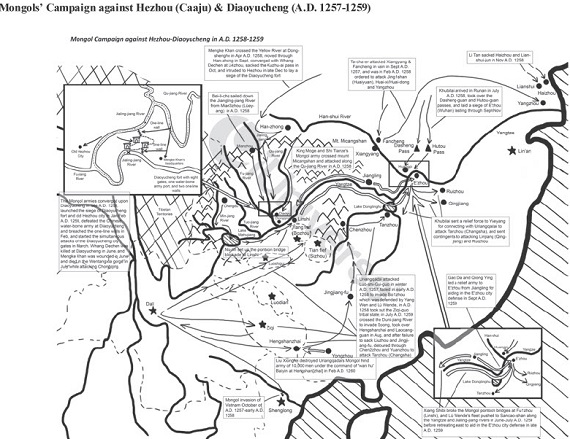
Mongol Campaign against the Jurchens (Battle of Yehuling, July of A.D. 1211)
Mongol Campaigns against Semiryechye & Central Asia (A.D. 1216-1219, 1219-1224)
Mongol Campaign against Kiev Rus (A.D. 1223)
Mongol Campaign against the Jurchens (A.D. 1231-1232)
Mongol Campaigns against the Volga Bulgars, Kipchaks, Alans, Rus Principalities, Crimea, Caucasus & Kiev Rus (A.D. 1237-1240)
Mongol Campaigns against Poland, Bohemia, Moravia, Hungary, Austria & Dalmatia (A.D. 1240-1242)
Mongol Campaign against Arsacia (Mulahida) from A.D. 1253 to A.D. 1256
Mongol Three-prong Campaign against Hezhou (Caaju) from late A.D. 1255 to early A.D. 1256
Mongol Continuous Campaigns in the Sichuan Basin (A.D.1257-1259)
Mongol Campaign against Hezhou (Caaju) & Diaoyucheng (A.D. 1257-1259)
Mongol Campaigns against the Abbasid Caliphate, Mecca, Misr (Egypt) Outposts, North Africa, and the Ayyubid & Mamluk Sultanates (A.D. 1257-1260)
|
|
Both Mengke Khan and Khubilai Khan
undertook pro-Confucian policies.
Mengke Khan, in A.D. 1251, continued Genghis Khan and Ogodei Khan's taxation policies as to the Confucians and other religion practitioners other than Judaism, namely, exemption from the 'ding' (adult) or poll tax.
Mengke called over a Tangut by the name of Gao Zhiyao who was a hermit in mount Helanshan,
to the Mongol court, and adopted the Tangut's suggestion of exemption of all services for the He-xi and North China Confucians.
Later, when Khubilai was enthroned, Gao Zhiyao petitioned for emancipation of Sichuan and Huai-he River Confucians who were enslaved by the Mongols, that impacted 3000 to 4000 Confucians.
Before returning to Helin, Arik-Buka (Ariq-boeke), a junior brother of Khubilai, held an assembly in Helin and declared himself 'khan'. Khubilai stopped at Jinlianchuan (Kaiping, i.e., Duolun, Cha'haer, Inner Mongolia) and declared himself Khan without an assembly. Yao Shu and Lian Xixian were ordered to make an announcement of the Khubilai enthronement in the Chinese language according to Cai Dongfan.
Xin Yuan Shi put Arik-Buka's separate enthronement at Hala-helin under the month of April.
It was Shang Ting who proposed to Khubilai as to boycotting Arik-Buka's khuriltai and taking proactive decision to announcement ascension ahead of Arik-Buka.
In April, on the 'xin-chou' day, a decree was issued, with the texts more likely authored by Confucian Wang E4, a former Jurchen Jin academician.
Xin Yuan Shi carried the complete passage of promulgation, with words to the effect that Khubilai took notice of lack of civil governance after over fifty years of Mongol military accomplishments, something not a single saintly predecessor Mongol emperor or court could have achieved.
The decree eulogized Mengke Khan's premature death with a claim of the Mongols' knocking on the 'Kui-men' gorge of the Yangtze ('dong kui-men zhi shi') but shedding tears at the cauldron lake ('yi ding-hu zhi qi'), which was citation of Earl Liu-xian-gong's words of promulgation with literary words and military detente with martial generals in Zuo Zhuan, as well as inference to a popular Tang dynasty literary tradition of likening the emperors' death to the Yellow Thearch's ascension to the heaven after completion of cauldron manufacturing at the foot of the legendary Jing-shan mountain.
A Chinese era was declared, namely, the First Year of the Zhongtong Era, A.D. 1259. Liu Bingzhong and Xu Heng revised on Genghis Khan's governmental structure of 'Duanshi-guan' (criminal prosecutor), 'Wan-hu' (10,000 head military chief), and Jurchen-style titles of 'yuan-shuai' (marshal) and 'xuan-hu' (pacifier) for provinces. The new structure will be i) 'zhongshu sheng' (state affairs), ii) 'shumi yuan' (military affairs), and iii) 'yushi tai' (promotion and demotion of officials). Lower levels will include shi, jian, yuan, si, wei, and fu. The provincial affairs would be handled by 'xing-sheng', 'xing-tai', 'xuan-hu', 'lian-fang' and 'muming zhangguan', and levels included 'Lu' (comprising of several provinces), 'Fu' (province or prefecture), 'Zhou' (smaller prefectures) and 'Xian' (county). But discrimination against the Chinese was rampant. The Mongols would assume the primary posts while the Han Chinese the deputy posts. The tax administration was mostly laid in the hands of the Muslims - allies of the Mongols. A caste society was established, with four levels differentiated: 1) the Mongols, 2) Se Mu Ren or Semuren, 3) Han-Ren (i.e., northern Chinese, the Khitans etc.), and 4) Nan-zi (the southern "Chinese-barbarians").
* In Commemoration of China's Fall under the Alien Conquests in A.D. 1279,
A.D. 1644 & A.D. 1949 *
 U.S.S.R./Comintern Alliance with the KMT & CCP (1923-1927)
U.S.S.R./Comintern Alliance with the KMT & CCP (1923-1927)
 Korean/Chinese Communists & the 1931 Japanese Invasion of Manchuria Korean/Chinese Communists & the 1931 Japanese Invasion of Manchuria
American Involvement in China: Soviet Operation Snow, IPR Conspiracy, Dixie Mission, Stilwell
Incident, O.S.S. Scheme, Coalition Government Crap, Amerasia Case & The China White Paper
* Stay tuned for "Republican China 1911-1955: A Complete Untold History" *
|
|
Zou Rong's Revolutionary Army;
Shin Kyu Sik's
Shrine (Spirit, Kunitama) of Korea
|
This snippet is for sons and daughters of China:
Heed the sons & ministers' agony and sorrow of our ancestors who died or lived through the Mongol, Manchu and Soviet-Chicom conquest
and
the Yongjia, Jingkang and Jiashen cataclysms !
Jeanne d'Arc of China:
Teenager girl Xun Guan breaking out of the Wancheng city to borrow the relief troops in the late Western Jinn dynasty;
Liu-Shao-shi riding into the barbarian army to rescue her husband in the late Western Jinn dynasty;
teenager girl Shen Yunying breaking into Zhang Xianzhong's rebels on the horseback to avenge on father's death in the late Ming dynasty.
China's Solitary and Lone Heroes:
Nan Jiyun breaking out of the Suiyang siege and charging back into the city in the Tang dynasty;
Zhang Gui & Zhang Shun Brothers breaking through the Mongol siege of Xiangyang in the Southern Soong dynasty;
Liu Tiejun breaking through three communist field armies' siege of Kaifeng in the Republican China time period;
Zhang Jian's lone confrontation against the communist army during the June 3rd & 4th Massacre of 1989.
|
|
|
Arik-Buka (Ariq-boeke), a junior brother of Khubilai, held an assembly in Helin and declared himself 'khan'. Lian Xixian, on his own initiative, frustrated the attempts of the Arik-Buka emissaries (Liu Taiping and Huo Luhuai) at Peking and defeated a general who answered Arik-Buka's order. Khubilai then attacked Arik-Buka and drove him off in A.D. 1261. At the advice of Liu Bingzhong, Khubilai Khan moved his capital to Peking in A.D. 1260, i.e., the winter capital Dadu ("great capital") or Khanbalik in Marco Polo's Cambaluc. This was in addition to the summer palace at Shangdu (the Xanadu of Coleridge). After being in reign for five years, Khubilai Khan declared a new era of Zhiyuan in A.D. 1263. Later in A.D. 1271, the Mongols adopted the dynastic name Yuan, meaning the first or origin.
Khubilai Khan sent an embassy, comprising of scholar officials Hao Jing, He Yuan and Liu Renjie, to Southern Soong. Southern Soong Prime Minister, in order to hide his previous treachery acts from Emperor Lizong (Zhao Yun, reign A.D. 1224-1264), would imprison the Mongol emissaries. Khubilai Khan sent another emissary to Soong border general Li Tingzhi. Li's report to Emperor Lizong was covered up by Jia Sidao.
Khubilai Khan issued a war decree in the second year of the Zhongtong Era (A.D. 1260). Mongol governor-general in charge of the Huai River and Yangtze areas, Li Zhan (Li Tan?), defected to Soong in the spring of the third year of the Zhongtong Era. Hearing of that, Khubilai Khan ordered Shi Tianze to attack the defector general at Ji'nan, Shandong. After a few months siege, the Mongols took over Ji'nan and killed Li Zhan via a cruel penalty of splitting the body.
The Siege Of Xiangyang
Around A.D. 1264, during the fifth year of the Zhongtong Era, Khubilai Khan changed his era to the Zhiyuan Era. Arik-Buka was spared and came to surrender. At this time, a Soong officer at Tongchuan, called Liu Zheng, being resented by Jia Sidao, would surrender his 15 prefectures to the Mongols.
Liu Zheng was conferred the posts of 'xing(2)sheng(3)' and 'an-hu-shi' of today's Sichuan areas. Liu Zheng proposed to have the Soong Chinese's grain supply cut off at Xiangyang. Soong Chinese General in Sichuan, Lü Wende, did not pay attention to Liu Zheng's building up the castles and cutting off Xiangyang and Fancheng, i.e., the twin forts, from today's Sichuan.
Lü Wende said that Xiangyang had ten years of grain supply. General Lü Wenhuan at Xiangyang wrote to Lu Wende, but he was ignored.
Serving under Liu Zheng was an officer called Sui Shichang who proposed to build the one-character wall to encircle the Xiangyang city.
Sui Shichang also proposed to build the artillery terrace outside of the Fancheng city for blasting at the twin-city defenders.
At Mt. Lumen-shan (deer gate), Sui Shichang defeated the Soong army, and at the Han-jiang-kou rivermouth, i.e., the Han-shui rivermouth, Sui Shichang defeated and burnt hundreds of Soong Chinese ships.
Liu Zheng and A-zu led the Mongols to Xiangyang and encircled it for four-five years.
The new Soong Emperor Duzong (Zhao Qi, reign A.D. 1264-1274) again conferred Jia Sidao important posts and added an extra title called 'Tai Shi', i.e., imperial tutor. Jia Sidao was extolled as comparable to Archduke Zhou of Western Zhou Dynasty. Jia Sidao pretended to resign several times, but Emperor Duzong would not let him go. Jia Sizong continued to shield the Xiangyang siege from the emperor. When a concubine told Duzong that Xiangyang had been under siege for 3 years, Jia Sidao would order that the woman be killed. The notoriety of Jia Sidao was best illustrated by another story: When one concubine of Jia Sidao saw a young man on the bank of Xihu Lake (West Lake) and exclaimed about the beauty of the young man, Jia Sidao would order that the young man be killed in front of the concubine.
This snippet is for sons and daughters of China:
Heed the sons & ministers' agony and sorrow of our ancestors who died or lived through the Mongol, Manchu and Soviet-Chicom conquest
and
the Yongjia, Jingkang and Jiashen cataclysms !
Jeanne d'Arc of China:
Xun Guan breaking out of the Wancheng city to borrow a relief army in the late Western Jinn dynasty;
Liu-Shao-shi riding into the barbarian army to rescue her husband in the late Western Jinn dynasty;
Shen Yunying breaking into Zhang Xianzhong's rebels on the horseback to avenge on father's death in the late Ming dynasty;
China's Solitary and Lone Heroes:
Nan Jiyun breaking out of the Suiyang siege and charging back into the city in the Tang dynasty;
Zhang Gui & Zhang Shun Brothers breaking through the Mongol siege of Xiangyang in the Southern Soong dynasty;
Liu Tiejun breaking through three communist field armies' siege of Kaifeng in the Republican China time period
;
Zhang Jian's lone confrontation against the communist army during the June 3rd & 4th Massacre of 1989.
|
|
In today's Sichuan, after Lü Wende died, his brother-in-law, Fan Wenhu, took over the post; but Fan, like his predecessor, refused to send the relief army to Xiangyang. At one time, Jia Sidao ordered Li Tingzhi and Fan Wenhu to aid Xiangyang. Fan Wenhu and his 100,000 were defeated.
In April, Li Tingzhi made the decision to send 100 ships and 3000 water-borne army to the relief of Xiangyang.
In May, Li Tingzhi deployed all troops at Ying3zhou (Zhongxiang) south of Xiangyang and Junzhou (Danjiangkou/Yunxian, Hubei) west of Fancheng.
Taking advantage of rising tides of the Han-shui River,
Zhang Shun and Zhang Gui, together with Fan Tianshun, in May departed Gaotougang (high head) port and sailed one hundred ships downstream for 120 leagues along the Han-shui River from Junzhou (Danjiangkou/Yunxian, Hubei), with canons, fire arrows, burning charcoal, huge hatchets and strong bows mounted at the front of ships.
Each ship carried thirty troops, plus one bag of salt and two hundred folds of cloth.
This relief mission was launched before the Soong court's allocated funds of tens of millions of money were to arrive in June.
Zhao-zhong Lu (book to propagate the loyalty), an anonymous book from the early Mongol Yuan dynasty, claimed that in May, the relief column took twenty-two days to reach Tuanshan (circled hill), and marched to Gaotougang (high head port) in two days, where the ships formed into a square shape.
At night, when water outflow clepsydra timekeeping device reached the third dial, the ships sailed with the red lantern as a signal.
Zhang Gui, leading the way ahead of Zhang Shun, cut the Mongol iron chains with huge hatchets during the night attack and broke through the Mongol midstream siege lines at Mohongtan (grinding flood beach).
The Mongol army troops, who were fully lined up on the ships, when jumping onto the bottom-less san-lian-zhou chained ships, fell into the water and drowned to death by ten thousand.
Zhang Shun died on the Han-shui River.
Xin Yuan Shi stated that the Mongols defeated and captured Zhang Shun on the 'kui-mao' day of August.
Zhao-zhong Lu stated that Zhang Shun's body flew to Xiangyang, and was found to have incurred four spear wounds and six arrows' wounds.
Zhang Gui entered Xiangyang at dawn on the 25th day according to Zhao-zhong Lu.
(This part of the history had conflicting dates, with Xin Yuan Shi pinning the Soong relief army's sail to Xiangyang under the month of August, not May-June.
Alternative records pointed to Zhang Gui's entering Xiangyang in June.)
This breakthrough with extra manpower and materials, May or August, greatly enhanced the defenders' morale.
After finding out that Xiangyang was in great urgency, Zhang Shun was to implement Li Tingzhi's plan to sail downstream for sake of appealing for aid with Fan Wenhu.
A brave man was hired to swim to Yingzhou (Zhongxiang) for connecting with Fan Wenhu's army.
In September, hiring two brave men and with 2000 troops, Zhang Gui departed Xiangyang
to seek conjunction with the Soong army at Ying3zhou (Zhongxiang, Hubei).
Zhao-zhong Lu stated that Zhang Gui scheduled the trip for July 7th after two sailors cut the water blockade fence and stumps and stealthily swam to Yingzhou to request the Soong army to come to Longweizhou for receiving the commandos.
But soon after Zhang Gui broke through the Mongol siege lines, at night, he encountered the Mongol ships at Xiaoxincheng (small new fort).
The Mongols set up an ambush after getting tips from one fleeing Soong solider and lit the two banks with torches.
At Goulintan (Julintan), near Longweizhou, Zhang Gui mistook the Mongol ships as the Soong relief fleet and ordered to raise the meteor-like fire signal.
Fan Wenhu and Xia Gui, sailing upstream, failed to connect with Zhang Shun when being impeded by the Mongols at Longweizhou (dragon tail island) and retreated thirty leagues two to three days ago.
Zhang Gui, who ordered the boats to return upstream,
was caught at Guimen-guan (ghost gate pass) by the Mongols who chased behind, and Zhang died in the Mongols' hands, with ten spear wounds on the body.
Xin Yuan Shi stated that the Mongols captured 'du-tong' Zhang Gui and over 2000 troops on the 'jia-zi' day of September.
Zhang Gui's body was sent to Xiangyang for displaying to the Xiangyang defenders so as to degrade the Soong Chinese morale.
Lv Wenhuan buried Zhang Gui and Zhang Shun together, likening them to Zhang Xun and Xu Yuan, i.e., Suiyang defenders of the Tang dynasty.
Then, the sister city of Fancheng was taken over by the Mongols, where two generals, Fan Tianshun and Niu Fu, died. The Mongols deployed catapults (made by the Persian engineers) against the outer wall of Xiangyang and destroyed it. Every time Lü Wenhuan climbed up the citywall, he would have tears while facing the south. A Mongol general called on Lü Wenhuan to surrender, saying that Lü Wenhuan had done his job by guarding Xiangyang for five years. After they broke the arrows to swear forgiveness and sincerity, Lü Wenhuan surrendered and was conferred the post of 'Da-dudu' or governor-general of Xiangyang and the Han-shui River areas.
* In Commemoration of China's Fall under the Alien Conquests in A.D. 1279,
A.D. 1644 & A.D. 1949 *
 U.S.S.R./Comintern Alliance with the KMT & CCP (1923-1927)
U.S.S.R./Comintern Alliance with the KMT & CCP (1923-1927)
 Korean/Chinese Communists & the 1931 Japanese Invasion of Manchuria Korean/Chinese Communists & the 1931 Japanese Invasion of Manchuria
American Involvement in China: Soviet Operation Snow, IPR Conspiracy, Dixie Mission, Stilwell
Incident, O.S.S. Scheme, Coalition Government Crap, Amerasia Case & The China White Paper
* Stay tuned for "Republican China 1911-1955: A Complete Untold History" *
|
|
Zou Rong's Revolutionary Army;
Shin Kyu Sik's
Shrine (Spirit, Kunitama) of Korea
|
This snippet is for sons and daughters of China:
Heed the sons & ministers' agony and sorrow of our ancestors who died or lived through the Mongol, Manchu and Soviet-Chicom conquest
and
the Yongjia, Jingkang and Jiashen cataclysms !
Jeanne d'Arc of China:
Teenager girl Xun Guan breaking out of the Wancheng city to borrow the relief troops in the late Western Jinn dynasty;
Liu-Shao-shi riding into the barbarian army to rescue her husband in the late Western Jinn dynasty;
teenager girl Shen Yunying breaking into Zhang Xianzhong's rebels on the horseback to avenge on father's death in the late Ming dynasty.
China's Solitary and Lone Heroes:
Nan Jiyun breaking out of the Suiyang siege and charging back into the city in the Tang dynasty;
Zhang Gui & Zhang Shun Brothers breaking through the Mongol siege of Xiangyang in the Southern Soong dynasty;
Liu Tiejun breaking through three communist field armies' siege of Kaifeng in the Republican China time period;
Zhang Jian's lone confrontation against the communist army during the June 3rd & 4th Massacre of 1989.
|
|
|
Demise Of the Soong Dynasty
At this time, Emperor Duzong died, and his four year old son, Emperor Gongdi (Zhao Xian, reign 1274-1275), was made into an emperor in A.D. 1275. The Mongols sent Shi Tianze and Bo-yan (Bayan, grandson of Subetei) on a full campaign against Soong. Shi Tianze died en route. Bayan ordered that A-zu head the first column and depart for the Yangtze from Xiangyang, with Lu Wenhuan as a fore-runner general; the 2nd column was to be headed by Mang-wu and was to depart from Yangzhou, with Liu Zheng as a forerunner general. Bayan took over numerous cities on the way, slaughtered one town, and killed and captured numerous Soong generals.
The Mongols sent Shi Tianze and Boyan (Bayan, grandson of Subetei) on a full campaign against Soong. Shi Tianze died en route.
Three prongs of the Mongol infantry, cavalry army and water-borne army, under 'Jing-Hu xing-sheng zuo chengxiang' Bo-yan (Bayan), attacked south along the Han-shui River.
In September, the Mongols reached Yingzhou (Zhongxiang), and then detoured around Zhang Shijie's Soong army to sack Fu4zhou (Xiantao/Mianyang).
In November, the Mongols reached Caidian, to the west of today's Hanyang, Wuhan.
Soong 'quan (interim) zhi Hanyang-jun' Wang Yi guarded Hanyang;
'quan interim) zhi E'zhou' Zhang Yanran guarded E'zhou;
'du-tong' Wang Da guarded Yangluo-bu;
and
'Jing-Hu & Sichuan xuanhu shi' Zhu Sisun acted as the water-borne mobile force.
The Mongols induced Xia Gui's Soong fleet to leave Shahu-kou for Hanyang while he made arrangement to attack the Shahu-kou estuary.
The Mongols then broke the dike of the Han-shui River to sail into the Lun-he River and then entered the Yangtze River via the Shahu-kou estuary.
In December of A.D. 1273, Xia Gui, as 'Huai-xi anhu zhizhi shi', led a relief to Yangluobu, near E'zhou, but fled the scene after learning that Mongol General A-zhu already crossed the Yangtze.
What happened was that Bo-yan, other than ordering A-li-hai-ya to continuing the attack against Yangluo-bu, sent A-zhu and 3000 cavalry westward to Qingshanji where they defeated Soong 'du-tong' Cheng Pengfei's fleet and then built a pontoon bridge to cross the Yangtze.
After Xia Gui fled east, Yangluo-bu was sacked by the Mongols in early A.D. 1274, with Wang Da killed in battle. Zhu Sisun retreated to Jiangling (Jingshan).
The Mongols then laid a siege of E'zhou, cut off the link between Hanyang and E'zhou, and pacified both cities.
In early A.D. 1274, A-zhu and Bo-yan's two-prong Mongol army attacked south and took over Yangluo, next to E'zhou.
In September of A.D. 1274, Bayan ordered that A-zhu head the first column and depart for the Yangtze from Xiangyang, with Lü Wenhuan as the fore-runner general; the 2nd column was to be headed by Mang-wu departing from Yangzhou, with Liu Zheng as forerunner general. Bayan took over numerous cities on the way, slaughtered one town, and killed and captured numerous Soong generals.
Bayan, leaving Mongol 'you cheng[-xiang]' A-li-hai-ya and 40,000 troops at E'zhou, took the main Mongol force to the east.
The Mongol army sailed downstream to attack the Wuhu area as well as sailed upperstream to attack Yueyang.
From the Huai-shui River, Mongol water-borne army under Hu-la-chu, i.e., the Shan-dong army troops under Hu-la-chu and 'can-zheng' Dong Wenbing, sacked Lu'an-jun and reached Anqing by September for the Dingjiazhou Battle in the Yangtze.
In January of A.D. 1275, Soong 'yan-jiang zhizhi fu shi' and 'zhi Huangzhou' Chen Yi surrendered to the Mongols.
This was followed by surrender of Guang Jingmo at Qizhou (Qichun, Hubei), surrender of 'ti-ju Jiangzhou' Lü Shukui and 'Jiang-xi anhu shi' Qian Zhensun, and surrender of 'zhi Nankang-jun' Ye Chang at Jiangzhou.
In February, 'zhi Anqing-fu' Fan Wenhu at Anqing-fu surrendered to the Mongols.
Soong Dowager Empress Xie-shi had no choice but to rely on Jia Sidao for fighting the Mongols. More Soong generals surrendered, including Fan Wenhu in Sichuan, Chen Yi in Huangzhou (the Huanggang area in today's Hubei). Hearing that Liu Zheng had passed away, Jia Sidao had a short ecstasy and led an army of about 130,000 against the Mongols, but he was defeated on the Yangtze River. In today's Jiangsu areas, around the Yangtze, Zhenjiang and Jiangyin were deserted in face of the Mongol attacks. Jia Sidao sent an emissary to Bayan for peace, but met with declination. Jia Sidao requested with dowager empress for relocation of the Soong capital, but Empress Xie-shi refused to move.
Several ministers at the Soong court requested that Jia Sidao be deprived of his posts, and Soong was to release the former Mongol emissaries like Hao Jing as a good-will gesture. At this moment, Zhang Shijie of E'zhou (Hubei Province), Wen Tianxiang of Jiangxi and Li Fei of Hunan came to the east to help the Soong court. Jiankang (i.e., Nanking) was deserted by a Soong general. Changzhou and Wuxi were next taken by the Mongols. Khubilai Khan then sent Lian Xixian and Yan Zhongfan to Soong for talking about ceasefire. Lian Xixian requested with Bayan for bodyguards, but Bayan advised that the more bodyguards Lian was to take with him, the more likely the Soong Chinese might harm him. Lian obtained 500 soldiers, but once Lian arrived at the Dusong-guan [lonely pine] Pass, Soong General Zhang Ru killed Yan Zhongfan and captured Lian Xixian. (History of the Yuan Dynasty stated that Lian was killed, too.) Bayan reprimanded the Soong's acts, and sent another emissary, Zhang Xu, to the Soong court together with a Soong emissary. Again, Zhang Xu was killed by a Soong border general. Then, the Mongols stopped the peace talks and attacked Yangzhou on the north bank of the Yangtze (Changjiang River). The Mongols attacked Yangzhou and defeated two generals under Li Tingzhi. The Jiading town surrendered next. Zhang Shijie's navy was defeated on the Yangtze by the Mongol fire attack. Wen Tianxiang arrived in Lin'an (Hangzhou) the capital, but Empress Dowager did not take his advice. Jia Sidao was expelled from the capital and he was killed by the escort official en route. Taizhou was lost to the Mongols, and Changzhou was slaughtered. In Hunan, Li Fei died, and both Hunan and Jiangxi Provinces were lost. After taking over the Dusong-guan Pass, the Mongols were closing in onto the Soong capital. A Soong minister called Liu Yue was sent to the Mongol camp for peace, but Bayan declined it, saying the Soong Emperor obtained the throne from a kid and would lose it in the hands of a kid. Lu Xufu was sent to the Mongols for expressing a wish to be a Mongol nephew, but the Mongols declined it. Soong's new prime minister, Chen Yizhong, sent Liu Yue to the Mongols in the attempt of expressing acknowledgement as a Mongol vassal, but Liu Yue was killed by a Soong Chinese civilian en route, at Gaoyou of Jiangsu Province. The Mongols then sacked Jiaxing and An'jie of Zhejiang Province. Wen Tianxiang and Zhang Shijie advised that the Soong court relocated to the islands in the seas, but Prime Minister Chen Yizhong decided to send the imperial seal to Mongols for a surrender. Bayan requested that Chen personally came to the Mongol camp. Chen fled to Wenzhou, a southern Zhejiang coastal city. Zhang Shijie led his people into the sea. Wen Tianxiang was made into the rightside prime minister and was ordered to go to the Mongols for peace. Wen was arrested by Bayan after he accused Bayan of invasion. In A.D. 1276, Bayan took over Lin'an and forced the dowager empress into issuing the surrender order. The Soong royal family, including the dowager empress and Emperor Gongdi, was sent to Peking.
Along the Canal, Wen Tianxiang slipped out of the Mongol camp, and took ride of a boat in the Yangtze for the seas, ahead of the Mongol troops' closing in.
Late Soong Emperor Duzong had two more sons, who were 11 and 6 year old, respectively. They fled to Wenzhou before Lin'an was taken by the Mongols. Chen Yizhong sailed them to Fuzhou of Fujian Province where a new Soong court was set up. Eleven year old Zhao Shi was made into Emperor Ruizong (reign A.D. 1275-1278). Zhang Shijie, Su Liuyi, and Lu Xiufu consecutively arrived in Fuzhou. Chen Yizhong was retained as leftside prime minister, while Wen Tianxiang, after fleeing from the Mongols, also arrived in Fuzhou and acted as rightside prime minister. The Soong court would last another three years before a final demise. The Mongols continued to push south. Canton (Guangzhou) of Guangdong Province was taken, where Soong General Huang Jun died. Yangzhou on the Yangtze Bank were taken, where General Li Tingzhi was captured and killed. The Mongols then invaded Fujian Province.
The Soong Court was frequently on the run, from one island to another, along the coast, and on May 8th of A.D. 1278, the new Soong Emperor died of illness within two years of enthronement. The now eight-year-old brother, Zhao Bing (King Wei-wang), was made the new emperor Di-bing on June 28th of A.D. 1278. Note Di-bing had no posthumous imperial title at all. Chen Yizhong died; Lu Xiufu was made into the leftside prime minister. When the Mongols attacked again, the Soong Court fled to Yashan, somewhere in the Pearl River and near Macao. Mongol General Zhang Hongfan led a surprise attack at Chaoyang (Chaoshan areas, Guangdong Province) and captured Wen Tianxiang who later wrote the famous poem entitled 'Ling Ding Yang' or 'Lingding Sea'. At the Yashan Island, Zhang Shijie nailed together his fleet, trying to defend the straits. Zhang Shijie declined Zhang Hongfan's invitation for surrender. After a defeat, Zhang Shijie broke through the siege with 16 ships. When chased by the Mongols, Lu Xiufu, with young emperor on his back, jumped into the sea with emperor on his back after driving his family into the sea. On February 26th of A.D. 1279, after driving his family into the sea, Lu jumped into the sea with emperor on his back. Zhang Shijie met with a hurricane near the Hailingshan Mountain, preyed that his ship sink should the Heaven intend to capsize the Soong Dynasty, and died when his ship was sunken. The Soong Dynasty officially ended in A.D. 1279, after a total of 320 years, including 152 (153?) years in southern China. The Soong royal tombs would be dug up by a Central Asian monk for treasures. Khubilai Khan declared the dynasty of Yuan ("first" or "beginning") in this year.
In Sichuan Province, as said by
Liu-sha-he, the Mongols sacked Chengdu city for a second time and left 1.4 million skeletons.
Liu-sha-he cited Yuan Dynasty's Heh Qingquan in stating that the Mongol army killed the Chengdu people in batches of 50 and repeatedly pierced the dead bodies to make sure the victims had been actually killed.
(Liu-sha-he also had comments on the Di[1] barbarians' massacring Chengdu in 301 A.D. as well as rebel Zhang Xianzhong's slaughter in A.D. 1644.)
The Yuan Dynasty (A.D. 1271-1368)
Khubilai Khan obtained his throne without a proper assembly, and hence he had lost the kind of mandate over ruling the other Mongol khanates. By moving the capital to Peking from Karakorum (rebuilt by Ogedei in A.D. 1235), he had changed the old Mongol yasaq. In the very beginning, Jochi's son, Batu, ruled the region to the north and west of Lake Balkash (extending from Hungary to the Kirghiz Plains, and from the lower Danube to the Caucasus); Chagadai was given the southwestern region to the east of River Amu-darya and to the southeast of River Syr-Darya, including today's Afghanistan, Turkestan, the former Naiman territories around the Altai, and central Siberia; Ogedei was awarded China and East Asia; Tului, the youngest of the four sons, was to have central Mongolia. Later, the Tului sons exterminated the ruling of Ogedei's descendants and diminished the domain of the Ogedei descendants, and the Chagadai domain was curtailed; Hulegu was given the territories beyond the Oxus River and the Hindu Kush. Nominally, Khubilai Khan was in charge of all khanates: 'Amu-darya Xingsheng' was in charge of Ilkhanate and Kipchak Khanate; 'Lingbei (north ridge) Xingsheng' was in charge of Ogedei Khanate; and two 'yuan shuai (marshal)' offices were in charge of Chagadai Khanate. A separate 'Liaoyang Xingsheng' was in charge of Manchuria.
In A.D. 1271, Khubilai declared the Yuan dynasty.
After declaring his dynasty of 'Da Yuan' (A.D. 1271-1368) on the 'yi-hai' day of November, A.D. 1271, Khubilai Khan could only be considered a ruler of China and Mongolia.
The edict claimed that the Mongols inherited the 'jing-ming' grand mandate,
standardized the dynastic epochs ('ji tong')
by
following the example of one hundred past kings [of Sinitic China] ('shao bai wang') -- which was a practice from remote antiquity ('long gu'),
and
adopted the 'Da Yuan' title that was embedded in the 'qian-yuan' name from The Book of Changes after tracing how the thearchs and sage kings derived their dynastic names, namely, Lord Yao's 'Tang2' meaning spacious and grand, Lord Shun's 'Yu2' meaning happy, Lord Yu's 'Xia' meaning large, and Shang King Shang-tang's 'Yin' meaning the middle (i.e., Sinitic center), etc.
(The Shang dynasty people never called themselves by 'Yin' which meant dark-red in today's usage, with the word likely adopted by the Zhou dynasty for labelling the Shang dynasty as decadent and cruel over the human sacrifice practice.)
Before subjugating the Southern Soong, Kubilai sent a fleet of 150 boats against Japan in A.D. 1274.
In A.D. 1281, Kubilai sent another expedition, with more than 160 000 soldiers, to Japan, but a typhoon would destroy the fleet, with those soldiers already on the Japanese shore mostly killed by the Japanese. The Japanese only spared the Southern Chinese and made them into slaves. Later, three Chinese fled to the continent.
According to Venerable Master Dongchu (1908-1977), Soong Dynasty's monks, who contributed to building the Japanese Zen Buddhism in Kamakura, worked diligently to obtain the Japanese assistance to revive the deposed Soong dynasty.
Monk Zu-yuan was said to have prayed days and nights in wishing his words to transform into the divine soldiers against the Mongol invaders.
In Dongchu's opinion, Kubilai's motivation in invading Japan was for sake of eradicating the Soong Chinese monks who were agitating in Japan for the restoration of Soong Dynasty.
Marco Polo supposedly had travelled to and stayed in China during the period of A.D. 1275 - 1292. Two years after the 1279 conquest of Southern Soong, the Kubilai's empress, an Onggirat woman, passed away. The Mongol khans had a custom of marrying the Onggirat women, a convention passed down from Genghis Khan. A niece of the empress would become the new empress. But Khubilai, though getting older, chose to go to the capital of Shang-du (i.e., Kaiping) for sake of indulging himself in concubines there (i.e., concubines from the past emperors).
Kubilai hired a Muslim as his finance minister, and this person, A-he-ma, had done his best to exploit the people in the iron and salt trades. A-he-ma's nepotism would include over 500 officials across the country. A-he-ma would later be killed by a 'qian hu' who issued an order in the name of the crown prince. Khubilai then renovated politics a bit by ordering Guo Shoujing to recompile a calendar, promoting the overseas trading, and inviting some Confucian descendant as the academy official. Rebellions broke out in coastal China of Fujian and Guangdong. Owing to rumors about the Soong revival, Khubilai relocated late Soong Emperor Gongdi (now Duke Yingguo-gong) to Shang-du and ordered that ex-Song prime minister Wen Tianxiang be executed should he refuse to surrender. Wen Tianxiang wrote a poem, stating that "Confucius proposed that one should die for compassion (Ren) and Mencius suggested that one should die for righteousness (Yi). Only when righteousness is fully exerted will the compassion be derived. What should I endeavour after educating myself with so many books of the ancient saints? However, I am sure that I feel no guilty about myself from this death moment on." (Confucius wording for 'Ren' should mean a broader sense of human perfection, similar to nirvana in Buddhism. 'Ren' also meant nucleus in Chinese, as used for the nucleus of various fruits like apple.) Khubilai, impressed by this poem, would confer a title of Duke Lulingjun-gong on Wen Tianxiang posthumously.
The Death Toll in the Hands of the Mongols
Forums where this webmaster had extensive discussions on the Mongol/Manchu massacres
http://www.chinahistoryforum.com/index.php?/topic/35697-chinas-outrageous-mortality-statistics/page__p__5005092#entry5005092
http://www.chinahistoryforum.com/index.php?/topic/19969-why-qing-survived-for-so-long/page__st__15
http://www.chinahistoryforum.com/index.php?/topic/13884-population-of-southern-song/
About the Soong population. It is
about time for me to go against the history books, and use my judgment to make
a case as to how many people had been killed and how the household ratios
changed during the said time period.
First, we want to say that the household numbers and the
headcounts were both valid, though not exact. The Soong Chinese families had a stable composition as to the children
born, and with the onset of the barbarian conquests by the Jurchens and the Mongols consecutively, the household ratio numbers changed in the Jurchen domain or the Mongol domain. The explanations could be: i) Possibly the conquerors and the surviving inhabitants took in the extra women, and ii) possibly the conquerors adopted the same policy as was practiced
by the Kim family in North Korea and by Mao in China, namely, encouraging the massive births,
was adopted, which should explain the extremely high ratio like 6.58 in
North China under the Jurchen rule (in A.D. 1187, with
6.789 million households but extraordinarily high headcounts of 44.7 million
people), the ratio of 5.44 in North China under the Mongol rule (in A.D. 1235,
with 0.873 million households but in contrast a higher headcount of 4.75
million people), and 4.46 in whole China under the Mongol rule (in A.D. 1290, with
11.8 million households but a higher headcount of 58.83 million people).
Now, let me explain the numbers by analyzing the households and headcounts.
Before the Jurchen conquest of North China in AD
1126, we had 20+ million households or 46.7+ million people. Namely,
AD 1100 ......... 19,960,812 households;
AD 1110 ......... 20,882,258 households or 46,734,784 people.
After the Jurchen conquest of North China, in AD
1218, about 92 years later, Southern Soong China had 12.669+ million households, south of the Huai-he River and the Qinling
Ridge, and inclusive of South China. (The rest fell under the Jurchen rule.)
Namely,
AD 1218 ......... 12,669,684 households (under the Southern Soong rule)
NOTE: ALTERNATIVE CLAIM POINTS TO THE APEX OF THE CHINESE POPULATION, prior to
the Mongol conquest, to be at 90+ MILLION
in A.D. 1222.
How do we reconcile the numbers? The household ratios had changed over the past
century. The number that was cited but was disputed to be inaccurate would
be the from-to numbers.
1195-1223年(金章宗明昌六年---南宋嘉定十六年)
7681万人
Namely, from A.D. 1195 to A.D. 1223, there were 76 million
people, not itemized either to the Jurchen territory
or the Southern Soong territory.
Validation:
Assuming that Southern Soong China continued the old practice, and using the AD
1110 ratio of 2.24, then we had at minimum [approx.] 28.4 million people under
the Southern Soong rule in A.D. 1218, while the population under the Jurchen rule would have FAR multiplied over the base of AD
1187 number of 44.7 million.
In sequential order, the numbers for the population under Northern Soong [AD 960-1127] were steadily increasing prior to the Jurchen invasion:
AD 1063, 12,462,531 households;
AD 1066, 14,181,486 households;
AD 1077, 14,245,270 households;
AD 1086, 17,957,092 households;
AD 1094, 19,120,921 households;
AD 1100, 19,960,812 households;
AD 1110, 20,882,258 households.
After the Jurchen invasion, the population under Southern Soong [AD 1127-1279] gradually recovered.
AD 1218 12,669,684 households;
AD 1223 19,202,500 households.
For the population under the Jurchens, there is a number from Jurchen Emperor Zhangzong's A.D. 1207 census, namely, 7.68 million households
or 45.81 million headcounts.
金章宗太和七年(1207) 户七百六八万,4581万
In sequential order, the numbers for the population under the Jurchen rule look to be in conformity with some constant
growth rate at peace times:
AD 1187 44.7 million head;
AD 1207 45.81 million heads.
Combining the Southern Soong population in A.D. 1223 with the Jurchen Jin population in A.D. 1207, we have
19,202,500 households * 2.26 + 45.81 million heads = 89.21 million heads.
So, the estimated from-to number of 76 million [from A.D. 1195 to A.D. 1223] for both Jurchen Jin [AD 1115-1234] and Southern Soong in A.D. 1223 is very
conservative, and the popular claim that the whole China possessed 90+ Million
people prior to the Mongol conquest is valid.
For the popular claim of a total of 93.47 million
in A.D. 1122-, see
http://www.google.co...iw=1157&bih=559
THE MONGOL CONQUEST
The brutal Mongol quest of the Jurchens decimated the
North China population, to a meager number of
873,781, namely 0.873 million households or 4.755
million headcounts in A.D. 1235 in North China. (This number must
have included the Mongol invasion forces from the steppe.)
Using the Mongol Yuan Dynasty records, the incremental population gain in North
China from A.D. 1235 to A.D. 1290 was another meager number of 0.4816 million
households.
Namely,
NORTH+SOUTH=13,196,206 households in A.D. 1290;
NORTH CHINA = 13,196,206 [South+North] - 11,840,800
[South China] = 1,355,406 households {North China] in A.D. 1290;
NORTHERN CHINA GAIN = 1,355,406 - 873,781 = 481,625 households from A.D. 1235 to
AD 1290. That was about 50% gain in about half a century.
In the ensuing half-century, there occurred Mongols' attrition wars against
Southern Soong, till the demise of the Southern Soong Dynasty in 1279.
There was an imperial
Southern Soong census number in A.D. 1264 of 5,696,989 households or 13,026,532
headcounts, maintaining the century old household ratio of about 2.29.
On the surface, for the Southern Soong dynasty, there was a halving of the
household numbers to 5.696 million in A.D. 1264 from 12.669 million in A.D. 1218.
What happened? At http://www.chinahist...ost__p__4848739 we discussed the attrition
warfare. Back in the first part of the century, in A.D. 1227, the Mongols began
to raid into Hanzhong and Sichuan, after conquest of
the Tanguts. From A.D. 1227 to A.D. 1290, the
population in the Sichuan area, which used to be 19.4% of Southern Soong China's
population in A.D. 1223 or 2.59 million households, was wiped out by the Mongols.
By A.D. 1290, there were only 100,000+ people left in the whole Sichuan basin,
from approximately the base of [approx.] 6 million people in A.D. 1223.
This 67-year attrition loss in Sichuan alone, from A.D. 1223 to A.D. 1290, was a
good mirror when comparing the nationwide drop of the household numbers to
5.696 million in A.D. 1264 from 12.669 million in A.D. 1218, which was a span of 56
years.
There were
several massive scale zigzag territorial changes: around A.D. 1261, a Southern Soong general for Tongchuan Circuit,
which used to be the name for the area around the Yellow River inflection point, called Liu Zheng,
for being resented by prime minister Jia
Sidao, surrendered his 15 prefectures to the Mongols.
Note 成都府路、潼川府路,
namely, the Chengdu (Sichuan) Circuit and the Tongchuan
Circuit, together with four circuits of the Southeastern China at the coast,
had the 72-73% of the total population of the Southern Soong Dynasty.
Alternatively speaking, the halving drop of the household numbers was very well
supported by the historical facts related to the two circuits.
In contrast with Liu Zheng's defection to the
Mongols, there was a general on the Mongol side, who defected to Southern Soong
with the land and people around the Huai-shui River.
The Number of 5.696 Million Households or 13
Million People in A.D. 1264
Please note that the above major event led to a
further drop in the population
when the rebellion quelling war was waged by the Soong court.
After one
year around civil war between Liu Zheng and the Soong
troops, Southern Soong managed to recover 3-4 prefectures.
The Mongols obtained part of the territory of Chengdu Circuit and the whole
Tongchuan circuit. See http://blog.sina.com...1f0100fr04.html for discussions on the loss of land and people in the western China.
The Number of 11,746,000 Households in A.D. 1276
versus Shang Yue's number of 9.3 Million Households
There was a dispute concerning the census data of
"11,746,000 households" in A.D. 1276, namely, the year the Southern
Soong dowager empress surrendered to the Mongols at the capital Hangzhou in
today's Zhejiang coastline. This number came from a book 《紫山大全集》 卷一一《效忠堂记》.
My point was that the
Mongols boasted of the conquest by claiming that the Southern Soong
court submitted the census books to the Mongols, but there was never ever a
census conducted in that year. The number of "11,746,000 households" of A.D. 1276 was either a rough census
that was taken by the Southern Soong court probably years before A.D. 1276, or most likely a number that Hu CHiyu (Hu Zhiyu), the said Mongol Han Chinese official who began to serve under the Mongols since A.D. 1260, derived independently of the household ministry.
Historian Shang Yue, 尚铖,
who was Kim Il-sun's teacher, had edited the book An
Outline of the Chinese History 《中国历史纲要》, in
which he pointed out that 元灭宋,得户九百三十万,
namely, after the Mongols destroyed Southern Soong, they obtained 9.3 million
more households. -So there is a discrepancy here between the number
of 9.3 million households from Shang Yue versus the paper number
"11,746,000 households" of A.D. 1276 from the editor of the book 《紫山大全集》 卷一一《效忠堂记》.
Note: Even if we use "11,746,000 households" of A.D. 1276 as a
reference, by A.D. 1290, there was virtually no change under the Mongol rule,
i.e., 11,840,800 households. This census of 11,840,800 households should have
included all domains of South China, including those taken by the Mongols
before the Yangtze Crossing of A.D. 1276, including the Southwestern China that was taken by the Mongols after the campaigns against Tibet and Vietnam but before the conquest against Southern Soong, and
the areas between the Huai River and Yangtze River,
where the Xiangyang city used to be the only LONELY
holdout during the period of 1267-1272.
AD 1276-AD 1290
In the interval of 24 years, from A.D. 1276 to A.D. 1290, South China had almost
no change in the total household numbers. What does that tell
you? It merely means that the prevalent growth rate among the Southern Chinese
had merely restored the population to 11,840,800 households in A.D. 1290, after
this many years. Remember that in North China, there
was an increase of 481,625 households from A.D. 1235 to A.D. 1290 or about 50% gain
in about half a century. You have to use an inverse growth rate to calculate
how the decimated Southern Soong households grew back to 11,840,800 households
in A.D. 1290.
While I acknowledge that Southeastern China did not incur the same wrath as
Sichuan's calamity of almost 99% population loss, the guess would be that 25% of the former
Southern Soong households were exterminated during the Mongol conquest.
Whatever on paper in A.D. 1276, namely, out of "11,746,000 households",
possibly one quarter was eliminated, or approximately 3 million households, and
after a quarter of a century, the households grew to 11,840,800 from the
decimated base, and using the hypothetical growth rate
of 25% for the quarter century time-frame, you very much fit in to the records.
Now, one more caveat, after a quarter of a century control by the Mongols, the
southern Chinese no longer observed the demography convention as before, and
hence you would have the household ratio of 4.46 in
AD 1290, no longer 2.24 or 2.26 under the former Soong rule.
THE FINAL DEATH-TOLL TALLY
Alternatively speaking, the population loss, using the households in
lieu of the headcounts, were far more severe. While the total
population South and North China combined in A.D. 1290 was 58 million, it did not
account for the household ratio change in both North China and South China. While
the North China ghost town was not disputed, the actual carnage for the South
China case has to be observed by examining the loss of households in South
China, not the headcounts.
A more precise approach would be to filter out
the "fake" or the extra population that was generated under the
Mongol hormone-policy, and then compare the new baseline
[removing the extra heads under the 4.46 ratio for calculation's sake] in AD
1290 with the figures prior to the Mongol quest. With this in mind, it is
reasonable to conclude that the Mongols had destroyed 80% of the original
Chinese population in both North China and South China.
In another word, for the total population South and North China combined in A.D.
1290, i.e., 58 million, you could only use half of it as the more accurate
numbers under the Soong ratio, and then compare against the 76 or 89.21 or 93.47 million heads - as discussed earlier. That means,
the Mongols destroyed 76 million - (58 million/2) = 47 million original
Chinese;
If using the original number of 90+ million, then
the Mongols destroyed 93.47 million - (58 million/2) = 64.47 million original
Chinese. <= Still not the full number, in my opinion.
* In the above, I divided the 58 million number by two, which was to normalize
the extra population growth by adopting the old 2.24-2.29 household ratio
versus the new 4.46 ratio
If Using the A.D. 1276 Cut-off Time for Southern
Soong & the A.D. 1235 for Jurchen Jin:
If using the A.D. 1235 cut-off number for Jurchen Jin, there
were 873,781, namely 0.873 million households or 4.755 million headcounts.
If using the A.D. 1276 cut-off time for Southern Soong, then there were 9.3
Million Households, and using the traditional Soong ratio of 2.29, there would
be 9.3*2.29 = approx. 21.3 million heads.
Then the Mongols would have eliminated
93.47 million - ( approx. 21.3 million Southern Soong +
[[approx 4.755 million in the former Jurchen
territory ]] ) = 67.42 million people.
Wu [no] Wang [forgetting] Zai [at] Ju [the Ju fort]
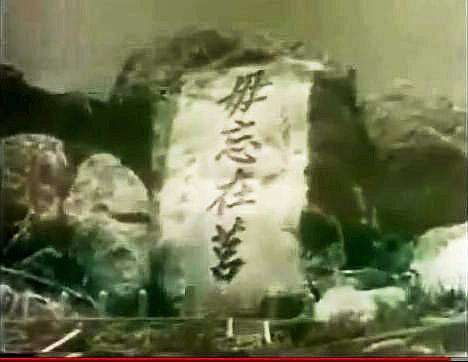
In Commemoration of China's Fall under the Alien Conquests in AD 1279,
AD 1644 & AD 1949
China was time and again invaded and raped by the "aliens" - whom this webmaster considered to be
i) the Mongols,
ii) the Manchus, and
iii) the Soviet proxies, consecutively.
For the future sons of China to read the following poem, see whether someone of you would revive the spirits of China,
and some day do some thing to reverse the fate of China, i.e., one billion coolies and slaves toiling to death for the multinational corporations and banksters under the supervision of the 'housekeeper' - the Chinese Communists or the former Soviet proxies.
(The Japanese invasion [AD 1931-1945], similar to the Jurchen invasion prior to the Mongol conquest, did not doom China as a whole as the Mongol conquest and the Soviet-ChiCom conquest subsequently did.)
The communists had conquered China owning to the key battle success in Manchuria, which was the result of treacheries on the part of Wei Lihuang, i.e., the government troops' commander-in-chief in Manchuria, a treachery that was comparable to Soong Dynasty prime minister Jia Sidao's abandoning to the Mongol the Xiangyang city [which was under siege for 4-5 years] and Ming Dynasty general Wu Sangui's betrayal of the Mountain and Sea Pass to the Manchus.
Wei Lihuang, with the communist mole by his side from the days of the resistance war, overrode General Wang Tiehan's proposal and made the government army into the sitting ducks in the isolated pockets and cities of Manchuria, for the communist army to attack.
Namely, Wei Lihuang allowed the communist army to take the transcendental secret manoeuvre to ship thousands of artillery to the foot of the Jinzhou city wall under the assistance of the Soviet railway army corps.
General Wang Tiehan suggested that the Changchun garrison troops could break out towards Mukden to the south as intelligence had shown that the communist army had disappeared along the trunk line of Changchun-Jirin-Mukden.
Only the 52nd Corps, that was hoodwinked by Wei Lihuang into attacking towards Shenyang [i.e., Mukden] as the relief troops but impeded by the communist army halfway for lack of coordination between Wei Lihuang and the communist army, managed to return to wrestle back the Yingkou port to escape the Manchurian battleground via sea.
A part of the Youth Army division, which broke out of the Mukden siege, fought its way along the Liao-xi Corridor to arrive at the Mountain and Sea Pass.
We don't need to remind the readers that the communist army was a motley group of mercenaries including about 250,000 ethnic-Korean Japanese Kwantung Army diehards per Kim Il-sun plus the Japanese 8th Route Army (i.e., the Japanese medical staff, airforce staff, officer corps, and tank and artillery operators), the ethnic-Taiwan Japanese Kwantung Army, the Outer Mongolian cavalry army, not counting the Soviet railway army corps.
According to the Soviets, the 'railway' tag was a guise for intervening in the Chinese civil wars, namely, the cloak of secrecy under which the Soviets orchestrated the historical Soviet conquest of China to fulfill Stalin's mantle that pro-Soviet regimes must be established in all territories that the Soviet Red Army ever stepped on, no matter Europe or Asia.
That is, Soviet military staff, not merely Soviet military advisers, fought the Chinese civil wars in Manchuria as the railway staff.
Ivan V. Kovalev, as Stalin and All-Union Communist Party (Bolsheviks)'s plenipotentiary to the Chinese Communist Party (CCP), was sent to China for directing the civil war as a railway czar.

George Kennan's Fallacious Disclaim of Soviet Instigation and Bankrupt 'Long' Containment View:
George Kennan
naively discounted
the Chinese communist revolution as "part of the Soviet system" and asserted its victory to be an
exception to the Soviet "military intimidation or invasion" and not a result that could be ascribed
"primarily to Soviet propaganda or instigation" (American Diplomacy, p. 119. The U of Chi Press 1951,
expanded edition).
George Kennan's bankrupt 'long' view as to communism was "a long-term, patient but firm and vigilant containment", which was to seek solutions in the "historical"
context, namely,
the "Russian or the oriental mind" of the "Russian-Asiatic world", something the communist China twin shared, that was
seemingly perceived as an innate matter that could not be overcome.

|
|
|
|
|
TEN TRAINS EQUIVALENT AMERICAN LEND-LEASE WEAPONS THAT STALIN & RUSSIANS GAVE TO MAO & CHINESE COMMUNISTS;
FORTY SHIPS EQUIVALENT QUANTITY OF TANKS & CANNONS, BOTH AMERICAN-MADE & JAPAN-MADE
3300 TONS OF PETROL FROM RUSSIANS IN 1947 ALONE; PLUS 2000 TONS OF DIESEL, 1000 TONS OF PLANE FUEL, 700 TONS OF EXPLOSIVES & 2000 TONS OF MACHINERY OIL
30000 TONS OF PETROL FROM RUSSIANS IN 1948; PLUS 1000 TONS OF PLANE FUEL, 5000 TONS OF KEROSINE, 3000 HEAVY WEIGHT TRUCKS & 150 ARTILLERY TRACTORS
DEATH OF MILLIONS OF YELLOW MEN, & POSSIBLY MORE IN THE FUTURE WAR AGAINST TAIWAN !!!!!
Reference: see the writing by James Perloff China Betrayed Into Communism on Friday, 24 July 2009 at
http://www.thenewamerican.com/index.php/history/world/1464
August Storm lend-lease weapons ended up in Mao's hands.
"At the Teheran and Yalta wartime conferences, however, Roosevelt asked Stalin if he would break his pact with Japan and enter the Far East war. Stalin agreed, but attached conditions. He demanded that America completely equip his Far Eastern Army for the expedition, with 3,000 tanks, 5,000 planes, plus all the other munitions, food, and fuel required for a 1,250,000-man army. Roosevelt accepted this demand, and 600 shiploads of Lend-Lease material were convoyed to the USSR for the venture. Stalin's Far Eastern Army swiftly received more than twice the supplies we gave Chiang Kai-shek during four years as our ally.
"General Douglas MacArthur protested after discovering that ships designated to supply his Pacific forces were being diverted to Russia. Major General Courtney Whitney wrote: 'One hundred of his transport ships were to be withdrawn immediately, to be used to carry munitions and supplies across the North Pacific to the Soviet forces in Vladivostok.... Later, of course, they were the basis of Soviet military support of North Korea and Red China.'
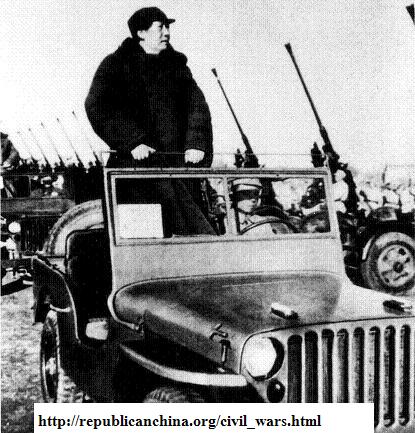
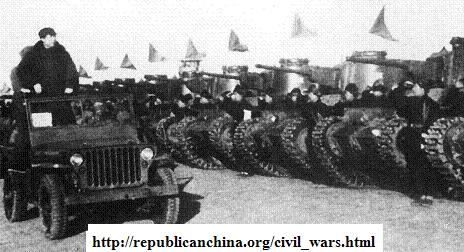
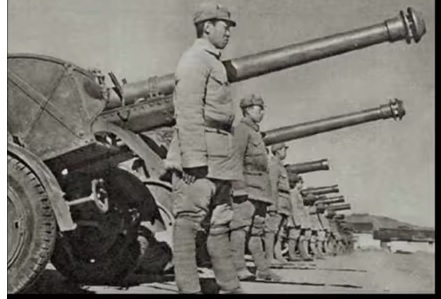
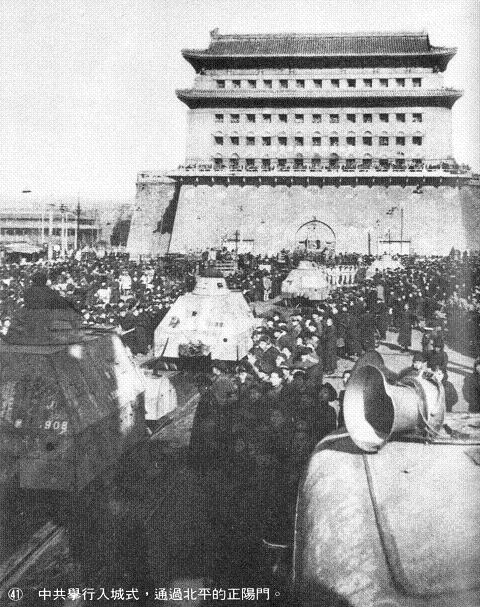
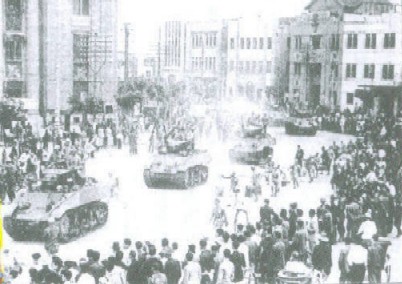
|
* In Commemoration of China's Fall under the Alien Conquests in AD 1279,
AD 1644 & AD 1949 *
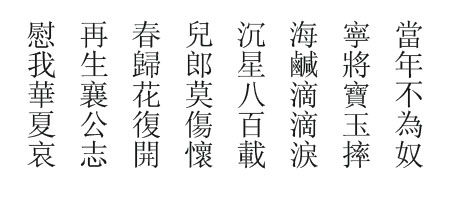
At the time [when China fell under the alien rule], refusing to be slaves,
[our ancestors] died as broken jades rather than being alive as an intact tile.
Tears, which tasted like the sea water, dripping down [the face] one by one,
For [China] the star [that fell from the sky] had been down [at the bottom of the sea] for 800 years.
Sons, please do not get saddened in the hearts,
For as the flowers did, they blossom when the spring returns.
When the [hegemony lord] Xianggong's swear is to be revived again,
The sorrow of the Flowery Xia Chinese would be soothed.
|
|
The Invasion of Japan
Champa & Annam
The Mongol Internal Strife
Khubilai exercised only the nominal ruling over the rest of khanates. The khanates, however, had already engaged themselves in disputes and wars. In A.D. 1265, Mamluk Baybars made an alliance with Berke Khan (Batu's brother and successor) against Hulegu. Berke withdrew when Khubilai sent 30,000 troops to aiding the Ilkhans. Arik-Buka (Ariq-boeke), the junior brother of Khubilai, had received the covert aid from Khan Haidu (grandson of Ogedei,i.e., Mongol Emperor Taizong posthumously). Arik-Buka later surrendered to Khubilai.
The grandson of Chagatai, Ya-er-gu, allied himself with Haidu. When Khubilai intended to oust Ya-er-gu, he called on the grandson of Batu (Mengke-timur) and the great grandson of Chagatai Ba-la for sake of an alliance against Haidu of Ogedei Khanate. But Ba-la of Chagatai Khanate colluded with Haidu in attacking Mengke-timur of the Kipchak Khanate. When Haidu was defeated by Mengke-timur, Ba-la encroached on the territories of Haidu. Haidu sought reconciliation with Mengke-timur, and Mengke-timur defeated Ba-la. Ba-la then threatened Haidu that he would ask Khubilai to attack him. Haidu sought reconciliation with Ba-la, too. The three khans held a khuriltai on the bank of the Talas River, and Haidu was proclaimed as the Grand Khan of the Mongols. Haidu then decreed to the Ilkhanate that they unite against Khubilai. The Ilkhanate khan, A-ba-ha, son of Hulegu, refused to follow Haidu; Haidu and Ba-la invaded the eastern Ilkhanate and called upon Mengke-timur to invade Ilkhanate from the northwest. A-ba-ha defeated Haidu and Ba-la, but he failed to beat back Mengke-timur. After A-ba-ha died, his brother would compete with A-ba-ha's son for the throne. Hence, Haidu gained an upper hand in the wars and moreover threatened to invade Khubilai's territories.
Khubilai dispatched Prince Ye-mu-han, Mengke's son Xi-li-jie and Muhuali's grandson An-tong against Haidu. Xi-li-jie defected to Haidu and arrested Ye-mu-han and An-tong. Khubilai then ordered prime minister Bayan to counter Haidu who was closing in on Helin. Bayan defeated Xi-li-jie and rescued Ye-mu-han and An-tong. Bayan was recalled by Khubilai when Nai-yan (the great grandson of the brother of Genghis khan) was reported to have planned rebellion in the areas between the Onon and Kerulen rivers of Mongolia. Bayan went to meet Nao-yan and failed to persuade Nai-yan. Bayan fled back to the Mongol capital. A Mongol minister recommended to Khubilai that once the khanates in the west were to be pacified, Nai-yan would succumb. This minister hence was ordered to go west and he claimed that Nai-yan had already succumbed to Khubilai. Hence the khanates all succumbed to Khubilai. After that, Khubilai led an army northward against Nai-yan. Seeing that his Mongol soldiers treated the Nai-yan soldiers with intimacy, Khubilai adopted the advice of a Chinese in having the Chinese army act as the forerunner column. General Li Ting tricked Nai-yan into a retreat and then defeated Nai-yan's army of 100,000 via a night attack using the cannons. Nai-yan was captured and executed. The remnant Nai-yan people then fled to Manchuria and attacked today's eastern Liaoning Province. Mongol 'Xuanwei-shi of Liaodong' Ta-chu requested for aid, and Khubilai sent his son over. Ta-chu defeated the Nai-yan remnants and chased them westward to the Altai. Ta-chu was conferred the title of 'wan hu'. The Nai-yan remnants, however, still remained for some time. Bayan was ordered to counter Haidu who harassed Helin in the west, and Prince Timur (grandson of Khubilai) was ordered to guard the Liao River area in the east. When a Mongol official defected to Haidu and attacked Khubilai's grandson (Gemala) near the Hang'aishan Mountain, Khubilai would lead a column to the north. Haidu retreated thereafter. Bayan would continue warfare with Haidu for some time before he left the post at Helin.
* In Commemoration of China's Fall under the Alien Conquests in A.D. 1279,
A.D. 1644 & A.D. 1949 *
 U.S.S.R./Comintern Alliance with the KMT & CCP (1923-1927)
U.S.S.R./Comintern Alliance with the KMT & CCP (1923-1927)
 Korean/Chinese Communists & the 1931 Japanese Invasion of Manchuria Korean/Chinese Communists & the 1931 Japanese Invasion of Manchuria
American Involvement in China: Soviet Operation Snow, IPR Conspiracy, Dixie Mission, Stilwell
Incident, O.S.S. Scheme, Coalition Government Crap, Amerasia Case & The China White Paper
* Stay tuned for "Republican China 1911-1955: A Complete Untold History" *
|
|
Zou Rong's Revolutionary Army;
Shin Kyu Sik's
Shrine (Spirit, Kunitama) of Korea
|
This snippet is for sons and daughters of China:
Heed the sons & ministers' agony and sorrow of our ancestors who died or lived through the Mongol, Manchu and Soviet-Chicom conquest
and
the Yongjia, Jingkang and Jiashen cataclysms !
Jeanne d'Arc of China:
Teenager girl Xun Guan breaking out of the Wancheng city to borrow the relief troops in the late Western Jinn dynasty;
Liu-Shao-shi riding into the barbarian army to rescue her husband in the late Western Jinn dynasty;
teenager girl Shen Yunying breaking into Zhang Xianzhong's rebels on the horseback to avenge on father's death in the late Ming dynasty.
China's Solitary and Lone Heroes:
Nan Jiyun breaking out of the Suiyang siege and charging back into the city in the Tang dynasty;
Zhang Gui & Zhang Shun Brothers breaking through the Mongol siege of Xiangyang in the Southern Soong dynasty;
Liu Tiejun breaking through three communist field armies' siege of Kaifeng in the Republican China time period;
Zhang Jian's lone confrontation against the communist army during the June 3rd & 4th Massacre of 1989.
|
|
|
Khubilai Seeking For the Confucians
In A.D. 1286, Khubilai ordered that yu-shi (Censor) Cheng Wenhai go to Southern China and seek the ex-Soong Confucians. Altogether twenty Confucians, including a Soong royal family member (Zhao Meng), were located and delivered to the Yuan court. Cheng Wenhai and an ex-Soong prime minister Liu Mengyan had both recommended an ex-Soong minister, by the name of Xie Fangde, for the Yuan court. Xie refused to eat food on the road to the capital, and he died in Peking after paying respect at the tombs of the ex-Soong empress and Duke Yingguo-gong (ex-Soong emperor). Another Confucian, by the name of Liu Mingyin who was an expert on Daoism and Neo-Confucianism, surrendered salaries to the Yuan court and left for his hometown. Yuan Dynasty's official in charge of the academy, 'Guo Zi Jian', ji-jiu (Wine Surrenderer) Xu Heng, had recommended another Confucian, Yang Gongyi, for the job of validating the calendar and endorsing the 'Civil Services Exam' system. Yang Gongyi resigned after finishing his work, and he died in the same year as Liu Mingyin, in A.D. 1293. Xu Heng was guilty of his serving the Mongols and asked his family not to erect a tombstone for him. Khubilai conferred Xu Heng the title of 'si-tu' and Duke Weiguo-gong posthumously for his contribution in reviving Confucianism and the spirits of Archduke of the Zhou Dynasty.
Invading Java, Declaring Amnesty, and Khubilai's Death
Khubilai replaced a prime minister (Sangge) when he found out about the corruption. Khubilai quelled numerous rebellions in southern Chinese provinces.
In January of A.D. 1293, Kubilai sent an army of 30,000 to Java and defeated the local ruler, only to be driven off by a Javanese ally. Khubilai thought about invading Annam again in A.D. 1293 because the new Annam king had bullied the Mongol emissary in A.D. 1291 and refused to come to the Yuan court to pay respect. When a meteorite was spotted in the sky, Khubilai inquired with his minister (Buwusu) about how to revert the Heaven's Omen as to his possible death. Buwusu cited Han Emperor Wendi's seeking repentance when 29 mountain quakes occurred on the same day and the sun eclipse occurred in the year. Khubilai recited Wendi's 'Decree In Regards To the Sun Eclipse', opened the royal grain barns for aiding the hunger-stricken people, and declared a general amnesty. When Khubilai fell ill again, Prime Minister Bayan was recalled to the capital from Datong. On February 18, 1294, Kubilai died at the age of eighty, after a reign of 35 years. Khubilai was given the posthumous title of Shizu (hereditary ancestor).
Emperor Chengzong (Borjigin Timur, reign A.D. 1294-1307)
With the help of Bayan, Khubilai's grandson, Timur, was proclaimed the successor, i.e., Emperor Chengzong after the Mongol court went through a power vacuum for a few months. Timur gave his father (Zhenjin) the posthumous title of Emperor Yuzong. Timur released an Annam emissary to show his goodwill. Timur conferred the title of 'tai shi' onto Yuexi-timur, 'tai fu' onto Bayan, and 'tai bao' onto Yue-chi-cha-er. Bayan, who previously commanded the 200,000 troops against Soong, passed away in this year at the age of 59. In A.D. 1296, rebellion erupted in Jiangxi. The next year, a Buddhist monastery on the Wutaishan Mountain was completed at a cost of over 10,000 human lives. Phagsba's disciple was responsible for pushing this project. At the times of Khubilai, Phagsba was made into an imperial tutor, and the Tibetan Buddhism was made into the national religion. Phagsba was responsible for devising the new Mongol script, with 41 letters. Phagsba was conferred the title of 'Da Bao Fa Wang', i.e., the grand treasure king for enforcing laws. Empress Onggirat led a huge column onto the Wutaishan Mountain. A Chinese official rebuked the rampant behavior of Buddhist monks who came from the West.
 Now, the Scourge-of-God-Tetralogy.
Book III of
The Barbarian Tetralogy, i.e., this webmaster's barbarism series, is finally released in September of 2022 by iUniverse. This barbarism series would be divided into four volumes covering the Huns, the Xianbei, the Turks, the Uygurs, the Khitans, the Tanguts, the Jurchens, the Mongols and the Manchus.
Book I of the tetralogy would extract the contents on the Huns from
The Sinitic Civilization-Book II,
which rectified the Han dynasty founder-emperor's war with the Huns on mount Baideng-shan to A.D. 201 in observance of the Qin-Han dynasties' Zhuanxu-li calendar.
Book II of the Tetralogy would cover the Turks and Uygurs.
And
Book IV would be about the Manchu conquest of China.
Now, the Scourge-of-God-Tetralogy.
Book III of
The Barbarian Tetralogy, i.e., this webmaster's barbarism series, is finally released in September of 2022 by iUniverse. This barbarism series would be divided into four volumes covering the Huns, the Xianbei, the Turks, the Uygurs, the Khitans, the Tanguts, the Jurchens, the Mongols and the Manchus.
Book I of the tetralogy would extract the contents on the Huns from
The Sinitic Civilization-Book II,
which rectified the Han dynasty founder-emperor's war with the Huns on mount Baideng-shan to A.D. 201 in observance of the Qin-Han dynasties' Zhuanxu-li calendar.
Book II of the Tetralogy would cover the Turks and Uygurs.
And
Book IV would be about the Manchu conquest of China.
From the Khitans to the Jurchens & Mongols: A History of Barbarians in Triangle Wars and Quartet Conflicts
, i.e., Book III of
the Scourge-of-God-Tetralogy,
focused on the Khitans, Jurchens and Mongols, with the missing one-year history of the Mongols' Central Asia campaigns rectified.
This webmaster, other than the contribution to the Sinology studies in rectifying the Huns' war to 201 B.C., and realigned the missing one-year history of the Mongol Central Asia war, had one more important accomplishment, i.e., the correction of one year error in the Zhou dynasty's interregnum (841-828 B.C. per Shi-ji/840-827 per Zhang Wenyu) in
The Sinitic Civilization-Book I, a cornerstone of China's dynastic history.
|
The Scourges of God: A Debunked History of the Barbarians
From the Khitans to the Jurchens & Mongols: A History of Barbarians in Triangle Wars and Quartet Conflicts
(The Barbarians' Tetralogy - Book III)
Epigraph,
Preface,
Introduction,
Table of Contents,
Afterword,
Bibliography,
References,
Index
|
|
Emperor Chengzong (Borjigin Temur, r. A.D. 1294-1307) ......................692
Emperor Wuzong (Borjigin Qayisang, r. A.D. 1307-1311) ..........................693
Emperor Renzong (Borjigin Ayuur-balbad, r. A.D. 1311-1320) .................693
Emperor Yingzong (Borjigin Sidibala, r. A.D. 1320-1323) ...........................695
Emperor Taidingdi (Borjigin Yisun-temur, r. A.D. 1323-1328) ...........................696
Emperor Tianshundi (Borjigin Razibay, r. A.D. 1328) ........................... 696
Emperor Wenzong (Borjigin Tob-temur, r. A.D. 1328-1329, 1329-1332) .................697
Emperor Mingzong (Borjigin Kusele/Kusala, r. A.D. 1329) ............................697
Emperor Ningzong (Borjigin Rincinbal, r. A.D. 1332) ...................................698
Emperor Shundi (Borjigin Toyan-temur/Toghan-temur, r. A.D. 1333-1370) .. 698
Chapter XLI: The Red Turbans' Rebellion Against the Mongols ................701
Chapter XLII: The Ming Dynasty vs. the Mongols ....................720
Expulsion of the Mongols
The Mongol discrimination against Chinese should be the top cause for the ending of its rule in China.
Xu Dachao, a Soong-Yuan survivor from today's Suzhou, in "jin yu lu [records from the ember of the Mongol fire]", recorded the barbaric Mongol Droit du seigneur against the ethnic Chinese brides.
The ethnic Chinese, who had to surrender their brides' first night, had a tragic practice of killing the first born babies to preserve the line's integrity and purity in accordance with the Confucian standards.
The other causes would be collusion with the Tibetan lamas in depriving the Chinese of their lands.
Still more causes would be the paper currency over-circulation, which caused inflation to go up ten folds during Yuan Emperor Shundi's reign, an important cause for the Mongol loss of power. Yuan's Prime Minister Toktoghan (Tuo Tuo), against an objection by a Chinese official (Lu Sicheng) in charge of Guo Zi Jian (i.e., Confucian Academy), printed over five versions of the paper currency. Still one more cause would be the Yellow River flooding as a result of the Mongols' abandoning the irrigation projects. In the Mongol times, the Chinese agriculture lands were very much in wastage. Once the hundreds of thousands of Chinese civilians were called upon to work on the Yellow River, the time was ripe for a great rebellion.
In history, China's dynastic substitution was mostly the results of usurpation, mutiny or foreign invasion, except for the Yellow Turbans of Eastern Han Dynasty and the Red Turbans of Yuan Dynasty.
China's dynasties twice changed by the religious organizations, namely, Zhang Jiao's Daoist "Yellow Turbans" in the late Han Dynasty, and Yuan Dynasty's Red Turbans that were related to "Ming" [bright] religion.
History, though a mirror, may not have to repeat.
(Religious agitations might not work in the 21st century, as in the case of the Fa Lun Gong movement. Religion-related rebellion that had crippled but failed to topple a dynasty would be the "White Lotus Society" and the "Taiping Heavenly Kingdom", incidentally. This webmaster had also read about Wang Dan's interpretation of today's China as conducive to a similar Chen Sheng & Wu Guang rebellion of the late Qin Dynasty, which was another mis-reading of history.)
Religion was used by the Chinese in rebelling against the Mongols.
The secret societies rebelling against the Mongol rule would be mixed combination of Taoism, Buddhist elements and Central Asia religion.
Major branches would include the White Lotus Society ("Bailian Jiao"), White Cloud Society ("Baiyun" by Kong Qingjiao), and "bright" religion ("Ming Jiao").
Mao Ziyuan of the Southern Soong Dynasty first founded the "White Lotus Society" as a Mahayanist sect of Buddhism with adoration for bodhisattva Amitabha; however, the sect had transferred the adoration to a different buddha [Maitreya Buddha?] by the Yuan Dynasty. (Later, in the 16th century, the "White Lotus Society" developed into hundreds of sub-sects, with occurrence of major uprising against the Manchu rule in A.D. 1796.)
Radical Chinese historians, who had attributed Zhu Yuanzhang's Ming Dynasty to an alien rule belonging to the Muslims, had pointed out that the character "ming" to the fire adoration religion of the Central Asia.
The Red Turbans, i.e., "Hongjin Jun", which overthrew the Mongol rule, derived from the "bright religion" [? Zoroastrianism
mutation].
 The Scourges-of-God Tetralogy
would be divided into four volumes covering
Hsiung-nu (Huns), Hsien-pi (Xianbei), Tavghach
(Tuoba), Juan-juan (Ruruans), Avars, Tu-chueh (Turks), Uygurs (Huihe), Khitans, Kirghiz, Tibetans, Tanguts, Jurchens, Mongols and Manchus and
southern barbarians.
Book I of the tetralogy would extract the contents on the Huns from
The Sinitic Civilization-Book II,
which rectified the Han dynasty founder-emperor's war with the Huns on mount Baideng-shan to A.D. 201 in observance of the Qin-Han dynasties' Zhuanxu-li calendar.
Book II of the Tetralogy would cover the Turks and Uygurs.
And
Book IV would be about the Manchu conquest of China.
The Scourges-of-God Tetralogy
would be divided into four volumes covering
Hsiung-nu (Huns), Hsien-pi (Xianbei), Tavghach
(Tuoba), Juan-juan (Ruruans), Avars, Tu-chueh (Turks), Uygurs (Huihe), Khitans, Kirghiz, Tibetans, Tanguts, Jurchens, Mongols and Manchus and
southern barbarians.
Book I of the tetralogy would extract the contents on the Huns from
The Sinitic Civilization-Book II,
which rectified the Han dynasty founder-emperor's war with the Huns on mount Baideng-shan to A.D. 201 in observance of the Qin-Han dynasties' Zhuanxu-li calendar.
Book II of the Tetralogy would cover the Turks and Uygurs.
And
Book IV would be about the Manchu conquest of China.
From the Khitans to the Jurchens & Mongols: A History of Barbarians in Triangle Wars and Quartet Conflicts
, i.e., Book III of
the Scourge-of-God-Tetralogy,
focused on the Khitans, Jurchens and Mongols, as well as provided the annalistic history on the Sui and Tang dynasties, the
Five Dynasties & Ten Kingdoms, and the two Soong dynasties.
Similar to this webmaster' trailblazing work in rectifying the Han dynasty founder-emperor's war with the Huns to 201 B.C. in The Sinitic Civilization - Book II,
this Book III of the Scourge-of-God-Tetralogy
collated
the missing one-year history of the Mongols' Central Asia campaigns and restituted the
unheard-of Mongol campaign in North Africa.
|
The Scourges of God: A Debunked History of the Barbarians" - available at iUniverse|Google|Amazon|B&N
From the Khitans to the Jurchens & Mongols: A History of Barbarians in Triangle Wars and Quartet Conflicts
(The Barbarians' Tetralogy - Book III)
Epigraph,
Preface,
Introduction,
Table of Contents,
Afterword,
Bibliography,
References,
Index
|
|
Table of Contents
(From the Khitans to the Jurchens & Mongols: A History of Barbarians in Triangle Wars and Quartet Conflicts)
Chapter XLI: The Red Turbans' Rebellion Against the Mongols.........................................................701
Chapter XLII: The Ming Dynasty vs. the Mongols ............................................................................720
|
|
The Yellow River Flooding & The Red Turbans
The Yellow River flooding caused a massive damage to the people in Ji'nan area of today's Shandong Province. The Yellow River was first worked on by Lord Yu, and eight hundred years after, the Shang people began to experience the flooding again. Major river course changes had occurred for over half a dozen times in the past 3500 years. During the 25th year reign of Yuan Emperor Shizu (Khubilai),i.e., A.D. 1288, the River changed course. During the 1st year reign of Yuan Emperor Shundi, i.e., A.D. 1335, the bank was breached at Kaifeng, Henan Province; in A.D. 1344, breached at the Caozhou Prefecture and Kaifeng; in A.D. 1345, breached near Ji'nan, Shandong Province. A Chinese official, by the name of Jia Lu, proposed to have the river course changed to the Huai-shui River in the south. Toktoghan dispatched an official, Cheng Zun, on an inspection trip.
Cheng Zun proposed an alternative scheme by citing the fact that there were no royal savings for a huge project like Jia Lu's and that any mobilization of 200,000 laborers might cause the social instability. Toktoghan, angry with Cheng Zun for the suggestion that the people might rebel, petitioned with Emperor Shundi to have Jia Lu take charge of 170,000 soldiers and laborers to work on revamping the Yellow River course. Jia Lu started work in April of A.D. 1351 and finished work in July of the same year. However, the White Lotus Society, led by Han Shantong and Liu Futong, had secretly implanted a one-eye stone statute in the Huanglinggang area and then spread the rumor stating that rebellion would erupt should a stone man with one eye be dug up from the Yellow River's bed. Jia Lu did not pay attention to the stone man and ordered that it be destroyed. Liu Futong, after the Yuan Dynasty arrested and executed Han Shantong, would rally an army called the 'Red Turbans' and supported Han Shantong's son (Han Lin'er) as the leader. Cai Dongfan commented that the Mongols should have hired the displaced Shandong people as labor for repairing the Yellow River rather than mobilizing 170,000 people for the project.
Answering the 'Red Turbans' rebellion would be several more bands, including Li Er (Sesame Lee) in Xuzhou of Shandong Province, Xu Shouhui (a cloth vendor) in Qi-shui of Hubei Province. Guo Zixing rebelled against Yuan in Dingyuan in A.D. 1352. Zhang Shicheng (salt merchant) rebelled against Yuan in Taizhou of Jiangsu Prov in A.D. 1353. Before that, in A.D. 1348, Fang Guozhen (a salt worker and later a pirate) in Taizhou of Zhejiang had rebelled against the Mongols.
Toktoghan advised Emperor Shundi to put down the rebellion in Henan Prov first. Since Shundi did not want Toktoghan leave the court, Toktoghan's brother, Yexian-temur, was ordered to quell rebellion with an army of over 100,000. Yexian-temur first attacked the city of Shangcai and captured a Red Turban leader called Han Yao'er.
|
|
|
|
|
|
|
Sovereigns & Thearchs;
Xia-Shang-Zhou dynasties;
Zhou dynasty's vassalage lords;
Lu Principality lords;
Han dynasty's reign years
(Sexagenary year conversion table-2698B.C.-A.D.2018; 247B.C.-A.D.85)
|
|
The Sinitic Civilization - Book I is
available now on
iUniverse,
Barnes & Noble,
Amazon,
Google Play|Books
and
Nook.
The Sinitic Civilization - Book II is
available at
iUniverse,
Amazon and Barnes & Noble.
Check out the 2nd edition preface that realigned the Han dynasty's reign years strictly observing the Zhuanxu-li calendar of October of a prior lunar year to September of the following lunar year, and the 3rd edition introduction that had an overview of Sinitic China's divinatory history of 8000 years.
The 2nd edition preface had an overview of the epact adjustment of the quarter remainder calendars of the Qin and Han dynasties, and the 3rd edition introduction had an overview of Sinitic China's divinatory history of 8000 years.
The 2nd edition realigned the Han dynasty's reign years strictly observing the Zhuanxu-li calendar of October of a prior lunar year to September of the following lunar year.
Stayed tuned for Book III that is to cover the years of A.D. 86-1279, i.e., the Mongol conquest of China, that caused a loss of 80% of China's population and broke the Sinitic nation's spine.
Preview of annalistic histories of the Sui and Tang dynasties, the
Five Dynasties, and the two Soong dynasties
could be seen in
From the Khitans to the Jurchens & Mongols: A History of Barbarians in Triangle Wars and Quartet Conflicts
(The Barbarians' Tetralogy - Book III: available at iUniverse;
Google Play|Books;
Amazon;
B&N).
(A final update of the civilization series is scheduled for October of 2022, that would put back the table of the Lu Principality ruling lords' reign years, that was inadvertently dropped from Book I during the 2nd update.)
|
|
 Now, the Scourge-of-God-Tetralogy.
Book III of
The Barbarian Tetralogy, i.e., this webmaster's barbarism series, is released in October of 2022 by iUniverse. This barbarism series would be divided into four volumes covering the Huns, the Xianbei, the Turks, the Uygurs, the Khitans, the Tanguts, the Jurchens, the Mongols and the Manchus.
Book I of the tetralogy would extract the contents on the Huns from
The Sinitic Civilization-Book II,
which rectified the Han dynasty founder-emperor's war with the Huns on mount Baideng-shan to A.D. 201 in observance of the Qin-Han dynasties' Zhuanxu-li calendar.
Book II of the Tetralogy would cover the Turks and Uygurs.
And
Book IV would be about the Manchu conquest of China.
Now, the Scourge-of-God-Tetralogy.
Book III of
The Barbarian Tetralogy, i.e., this webmaster's barbarism series, is released in October of 2022 by iUniverse. This barbarism series would be divided into four volumes covering the Huns, the Xianbei, the Turks, the Uygurs, the Khitans, the Tanguts, the Jurchens, the Mongols and the Manchus.
Book I of the tetralogy would extract the contents on the Huns from
The Sinitic Civilization-Book II,
which rectified the Han dynasty founder-emperor's war with the Huns on mount Baideng-shan to A.D. 201 in observance of the Qin-Han dynasties' Zhuanxu-li calendar.
Book II of the Tetralogy would cover the Turks and Uygurs.
And
Book IV would be about the Manchu conquest of China.
From the Khitans to the Jurchens & Mongols: A History of Barbarians in Triangle Wars and Quartet Conflicts
, i.e., Book III of
the Scourge-of-God-Tetralogy,
focused on the Khitans, Jurchens and Mongols, with the missing one-year history of the Mongols' Central Asia campaigns rectified.
This webmaster, other than the contribution to the Sinology studies in rectifying the Huns' war to 201 B.C., and realigned the missing one-year history of the Mongol Central Asia war, had one more important accomplishment, i.e., the correction of one year error in the Zhou dynasty's interregnum (841-828 B.C. per Shi-ji/840-827 per Zhang Wenyu) in
The Sinitic Civilization-Book I, a cornerstone of China's dynastic history.
|
The Scourges of God: A Debunked History of the Barbarians (available at iUniverse|Google Play|Google Books|Amazon|B&N)
From the Khitans to the Jurchens & Mongols: A History of Barbarians in Triangle Wars and Quartet Conflicts
(The Barbarians' Tetralogy - Book III)
Epigraph,
Preface,
Introduction,
Table of Contents,
Afterword,
Bibliography,
References,
Index
|
|
Written by Ah Xiang
|
|

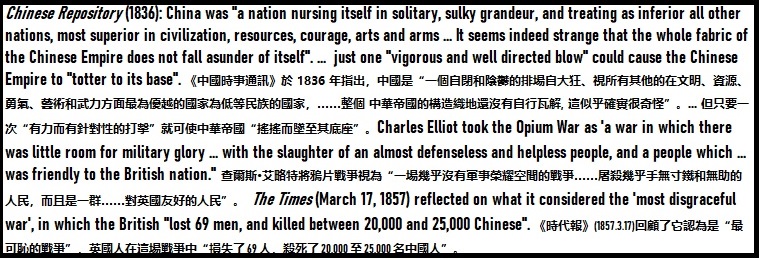
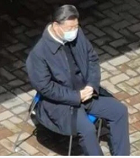








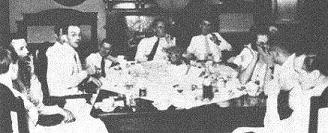
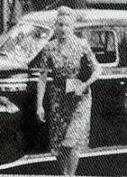
![Though, Anna Wang [Anneliese Martens], in her memoirs, expressed jealousy over Gong Peng by stating that the Anglo-American reporters had flattered the Chinese communists and the communist movement as a result of being entranced with the goldfish-eye'ed personal assistant of Zhou Enlai](GongPeng.jpg)
















